Early Views of the San Fernando Mission
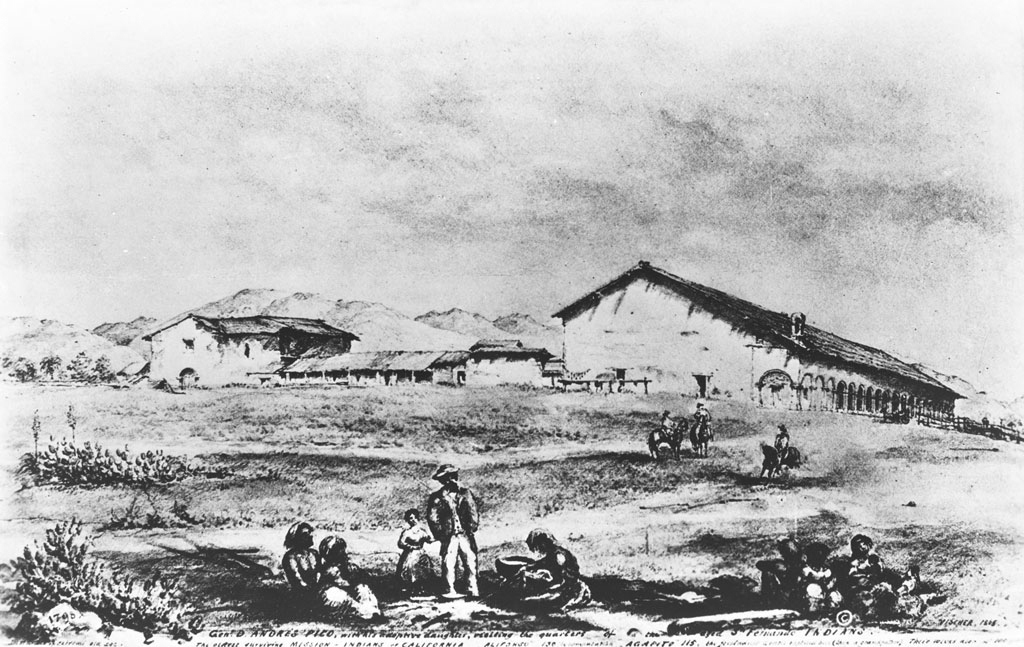 |
|
| (ca. 1865)* - Drawing by Edward Vischer depicting General Andrés Pico and two old Indians at the Mission San Fernando looking west, 1865. |
Historical Notes The San Fernando Valley was first discovered by the Portola expedition in 1769, but it wasn't until 1797 that San Fernando Mission was established. In the late 1790s, Father Lasuen, successor to Father Serra, wanted to close the gaps in the El Camino Real, and he established four missions in four months, including San Fernando Mission. The best spot in the area was claimed by Francisco Reyes, mayor of the Los Angeles pueblo. He had acquired rights to the land shortly after Los Angeles was founded, and he raised cattle there. Some say Reyes got his land from the king and had to be forcibly evicted, while others say he had simply been using the land and gave it up gracefully. |
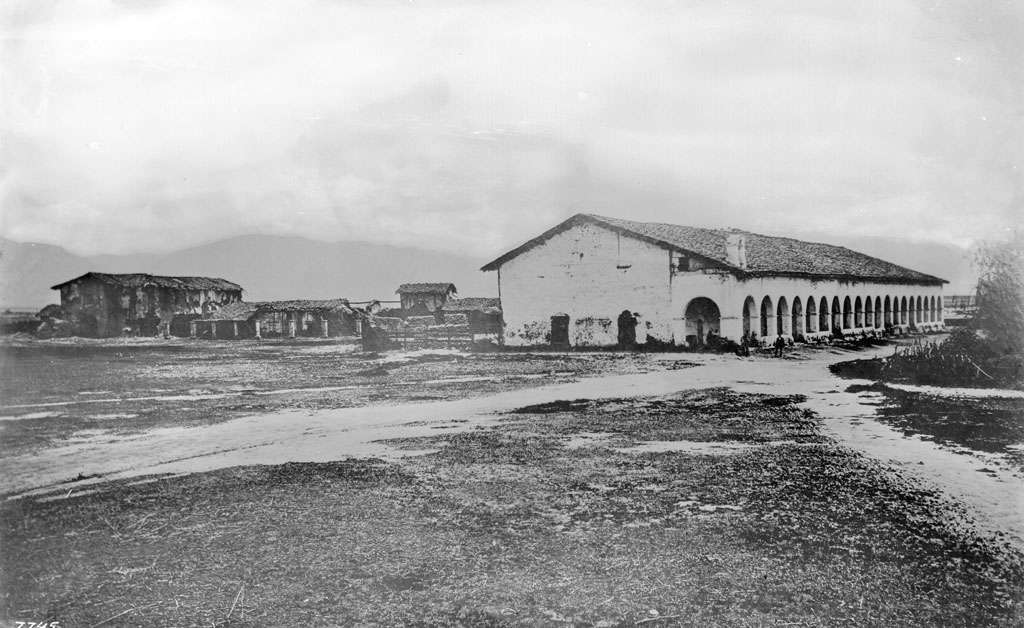 |
|
| (ca. 1870)* - Photograph of an exterior view of the Mission San Fernando. Two dirt paths enter in from the foreground, intersecting at the adobe cloister of the mission, which stands to the right of center. A collection of archways holds the eaves of the terracotta-tiled roof up over the cloister's patio. More adobe buildings can be seen to the left, with two-story adobe building standing to the left of an older cloister whose roof has collapsed. |
Historical Notes Father Padre Fermín de Francisco Lasuén de Arasqueta (June 7, 1736 – June 26, 1803) founded Mission San Fernando Rey de Españaon September 8, 1797. Sometimes called the "forgotten friar," Padre Fermín Lasuén actually governed the California Mission system three years longer than his more famous predecessor, Padre Junipero Serra. Lasuén was born at Vitoria in Álava, Spain on July 7, 1736 and joined the Franciscan Order as a teenager, entering the Friary of San Francisco shortly before his fifteenth birthday on March 19, 1751. On March 19, 1751, Lasuén was ceremoniously invested with his Franciscan habit. In 1759, he left Cádiz with seventeen other friars while still a deacon to volunteer for ministry in the Americas. He arrived in Mexico in 1761 and was sent to Baja California in 1768. Following the establishment of Mission San Diego de Alcalá in 1769, he went to Alta California in 1773. He based himself in San Diego and remained there until 1775. Father Fermín Lasuén also helped establish Mission San Juan Capistrano before the murder of Father Luís Jayme. Kumeyaay Indian unrest caused his return to San Diego and the general withdrawal of Spanish operations. In late 1776 he went to San Luis Obispo before again returning to San Diego in 1777 when he was made minister there. He was appointed the second Presidente of the missions in California in 1785, replacing Junípero Serra, and transferred to the Mission San Carlos Borromeo de Carmelo. On his death he was succeeded by Padre Pedro Estévan Tápis. |
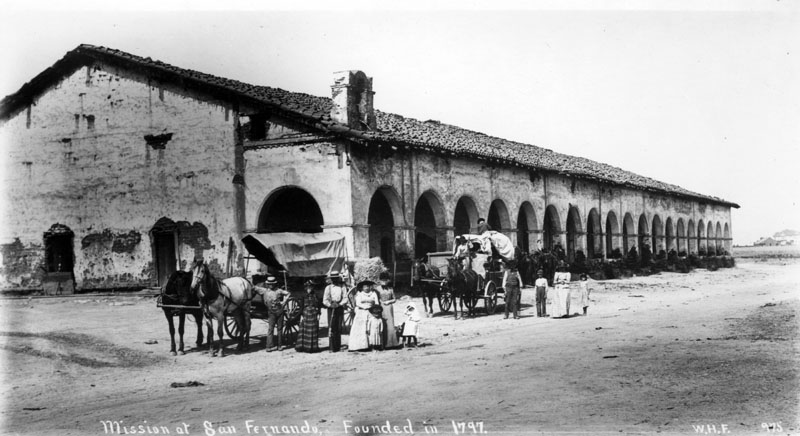 |
|
| (1800s)* - View of the Convento Building, also known as the "Long Building". Two families stand next to their horse-drawn carriages, which have stopped along the road that would eventually become "El Camino Real". |
Historical Notes Mission San Fernando Rey de España (originally La Misión del Señor Fernando, Rey de España) is located on the former settlement of Encino Rancho. It was the seventeenth mission built in Alto California. It was built in a quadrangle, similar to other missions, in which the church makes up one corner. The original church was built in 1797, but was soon outgrown; a larger chapel was built, but that one, too, soon proved to be too small for the growing population. A third, larger chapel was built and blessed in December 1806, but was completely damaged by the destructive earthquake of 1812 - once again, a new church was built and completed in 1818. By 1804, nearly 1,000 Indians lived at San Fernando Mission. By 1806, they were raising cattle and producing hides, leather good, tallow and cloth. Its closeness to Los Angeles and location along a popular traveling route made this place unique. Travelers stopped often, and the fathers kept adding onto the convento wing to accommodate them, until the hospice (hotel) became known as the "long building" of the El Camino Real. |
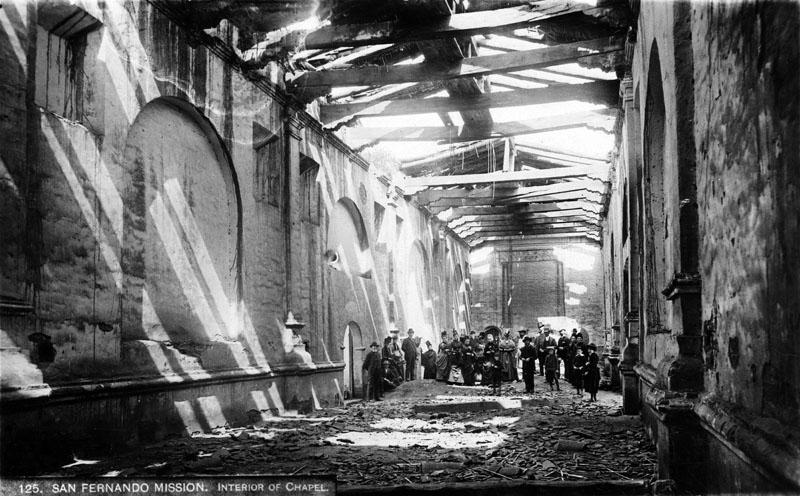 |
|
| (ca. 1812)* - Photograph shows a large group of people standing inside the adobe chapel adjacent to Mission San Fernando Rey de España after the 1812 earthquake, which all but destroyed it. Rubble litters the ground, and sunlight filters through the open roof. |
Historical Notes The 1806 church building was damaged in the 1812 earthquake and restored four times before the 1971 Sylmar earthquake did considerable damage. The rebuilt church was damaged again in the 1994 Northridge earthquake, and is now in good condition, though substantially reconstructed. |
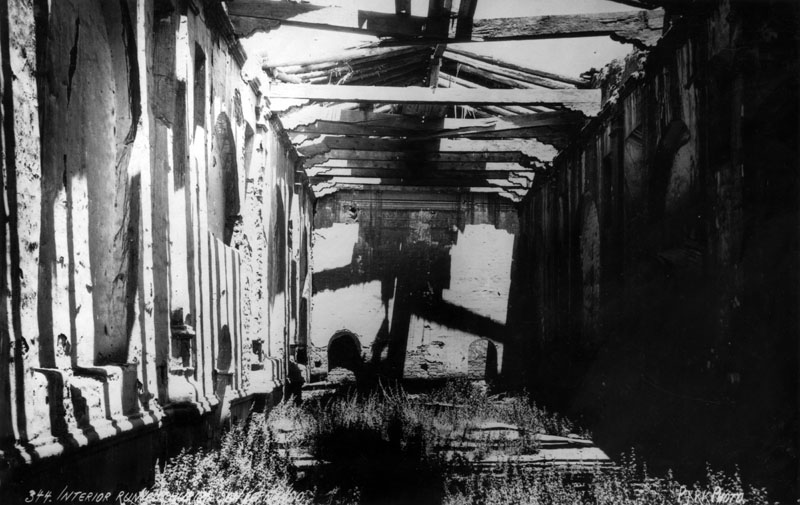 |
|
| (1800s)* - View of the interior of the adobe chapel adjacent to Mission San Fernando Rey de España after an earthquake all but destroyed it. Foliage has grown on the ground, and sunlight filters through the open roof. |
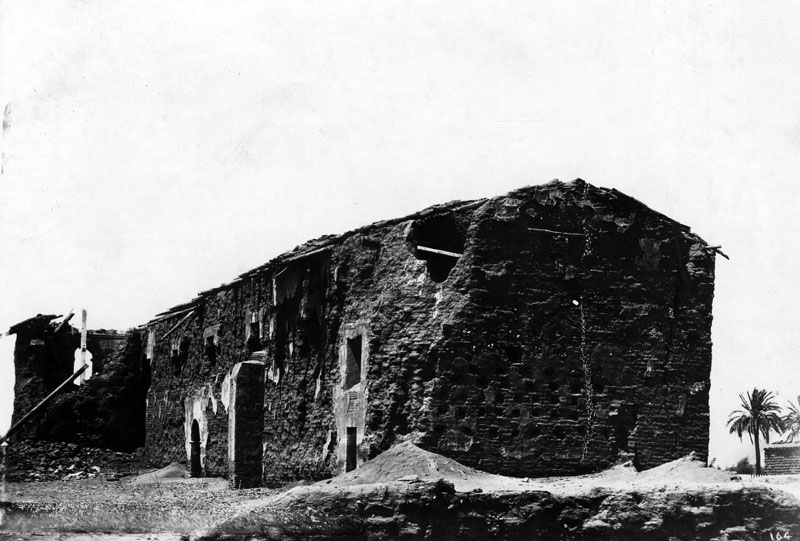 |
|
| (ca. 1800's)* - View of the original chapel structure in a state of ruin, many years prior to its restoration. Photograph shows the rear portion of the church and bell tower. Two palm trees can be seen in the distance on the extreme lower right. |
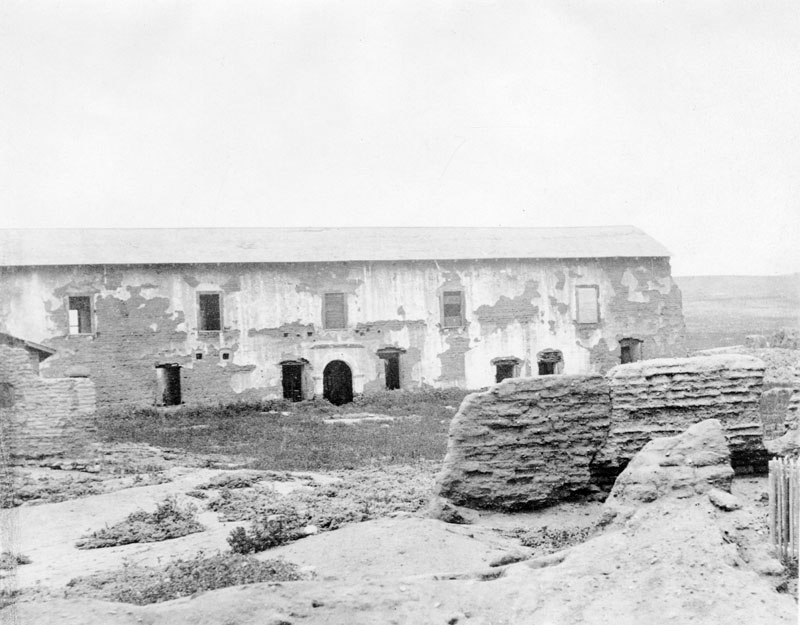 |
|
| (ca.1800s)* - View of the original chapel structure in a state of ruin, circa 1800s. Photograph shows the south portion of the church as well as a few crumbling adobe walls. |
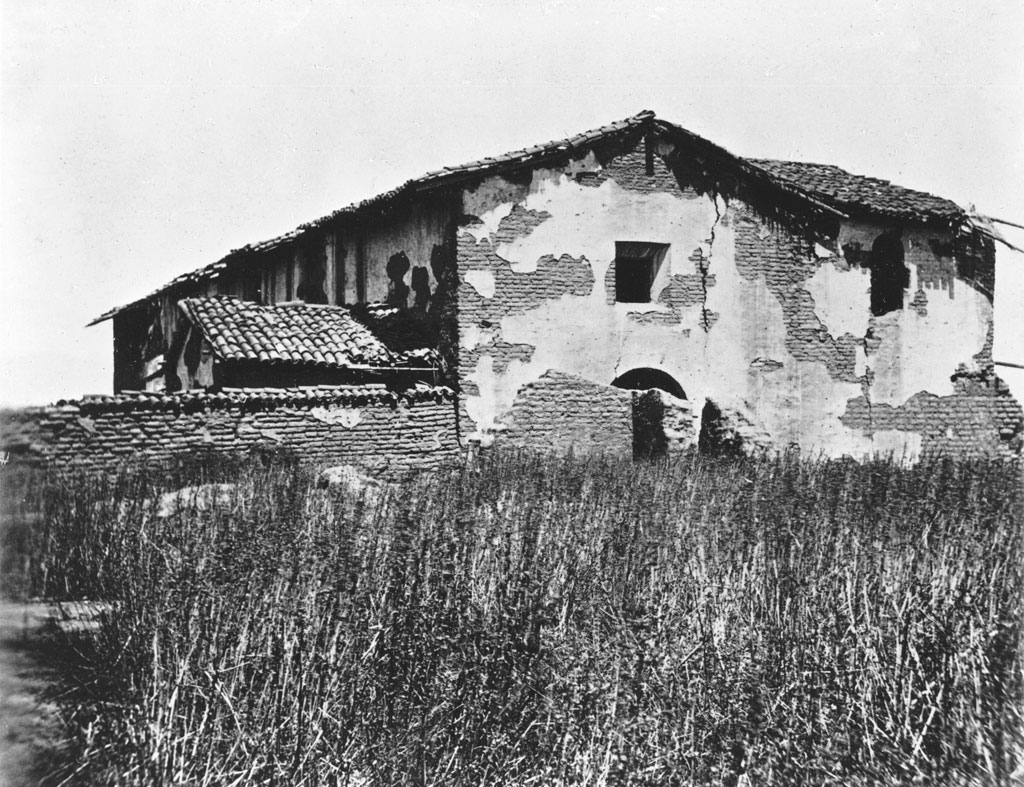 |
|
| (ca. 1857)* - Photograph of the Mission San Fernando Rey de España in disrepair, taken from(?) the bell tower in front of the church by photographer Edward Vischer, Los Angeles, prior to 1857. Dry, overgrown grass fills the foreground, behind which a two-story adobe building is losing its spackle. The building features several glassless windows and terracotta roof tiles. To the left, an adobe wall obscures part of a smaller building annexed to the front of the former. |
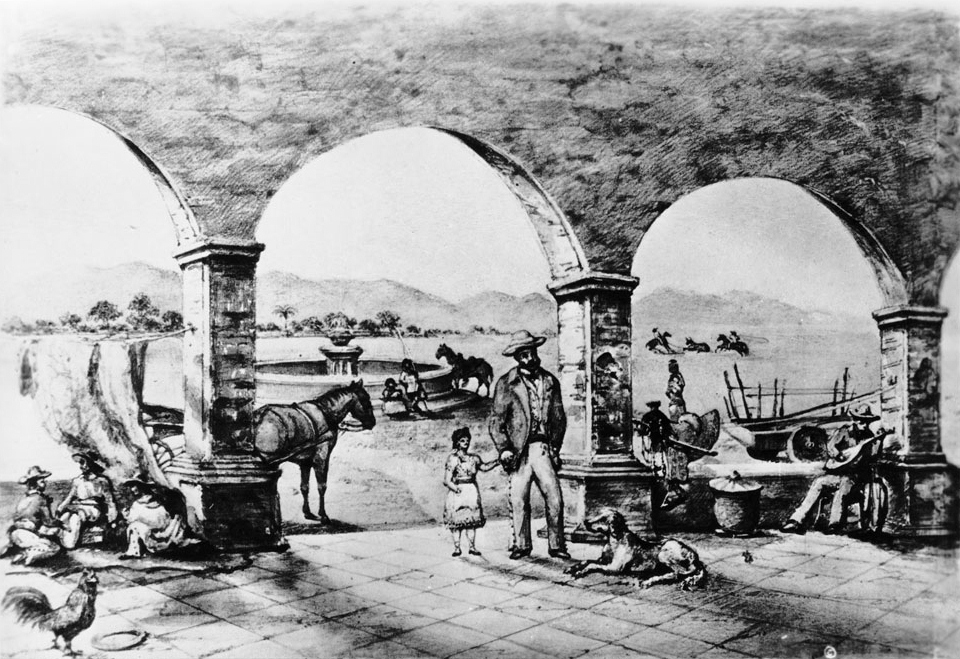 |
|
| (1865)* - Photograph of a drawing by Edward Vischer in 1865 of General Andrés Pico at San Fernando Mission. Pico stands in the corida de vaqueros (the exterior corridor) holding the hand of a child. A dog lays in front of him. Another man sits on a low wall under one of the arches supporting the roof, playing a guitar. Three people sit on the tile floor of the corridor at left. A chicken stands in front of them near an empty plate. In the background is a horse-drawn carriage, a fountain with two people and a horse beside it, and a group of horsemen riding in the distance as they lasso a steer. Caption reads: "Corridor of the farm building; a Californian magnate in his home; Ex-mission of San Fernando", "General Don Andrés Pico of Los Angeles, 1865", "Vaqueros lassoing cattle." |
Historical Notes After 1811, the San Fernando Mission native population began to decline, and productivity was threatened. By 1812, there were too few workers to farm the produce required for the military in Los Angeles. When the buildings were damaged by an earthquake in 1812, there were not enough workers to make the repairs. The struggle between northern and southern Californians over the land intensified, and in February, 1845, two armed groups met at the Cahuenga Pass. They shot at each other for half a day, but the only casualties were two horses and a wounded mule. The northerners then left, and Pio Pico became the new governor of California. In 1845, Governor Pio Pico leased the land to his brother Andrés for $1,200 a year. Andrés used it as a summer home. |
.jpg) |
|
| (1870)* - Photograph of an exterior view of the Mission San Fernando. The two-story main building of the mission is pictured to the left, having lost most of its spackle. A cloister extends out from it to the right, and features a terracotta-tiled roof that has collapsed inward in spots, the entire eave gone to the extreme right. A stretch of short, dry grass stands in the foreground. |
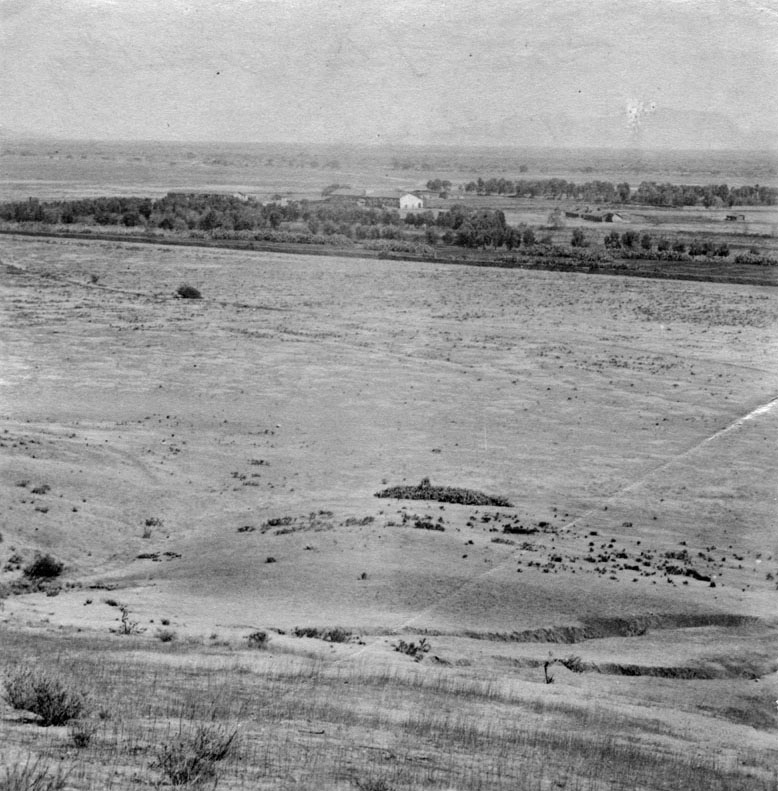 |
|
| (1873)* - This is the first known photograph of the San Fernando Valley. View is looking to the southeast, showing San Fernando Rey de España Mission in the center of the photograph. Apart from the mission, the vast land appears to be completely deserted. Mission San Fernando Rey de España is located at 15151 San Fernando Mission Boulevard. |
Historical Notes This is the first known photograph of the San Fernando Valley as seen in 1873. View is looking to the south, showing San Fernando Rey de España Mission in the center of the photograph. Apart from the mission, the vast land appears to be completely deserted.* Click HERE to see more in Early Views of the San Fernando Valley. |
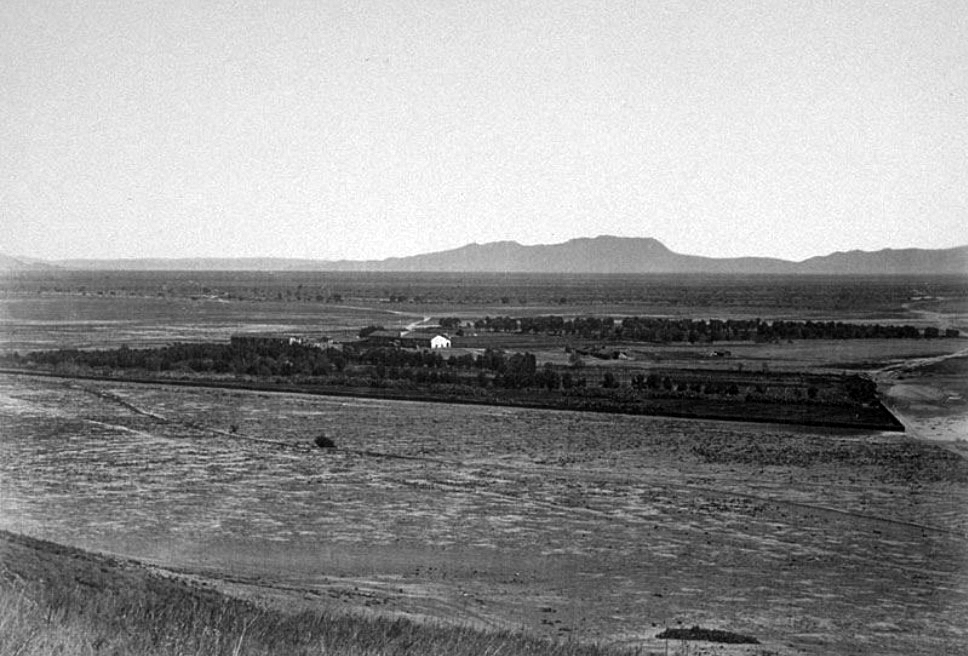 |
|
| (1873)* – Panoramic view of the San Fernando Mission looking southeast across a largely unimproved San Fernando Valley. In the distance are the Hollywood Hills with Cahuenga Pass (low point on the horizon in the upper-right) and the back of Mount Lee (highest peak and ridgeline). |
 |
|
| (ca. 1875)* - A closer view of the San Fernando Mission and the Valley looking southeast. A clearing stands in the foreground, separated from the buildings of the mission by a line of trees. The buildings stand mainly to the left: a long, two-story adobe can be seen most prominently, surrounded by smaller buildings. The ruins of shorter adobes stand to the right as well. Dirt roads and tree-dappled flatland extends behind them towards the mountains in the distance. |
.jpg) |
|
| (ca. 1875)* - Photograph of a front exterior view of the Mission San Fernando Rey de España ruins showing corridors, taken by photographer Edward Vischer, before 1875. A two-story adobe building stands to the left, visible behind the remains of adobe walls. The building's walls are losing their spackle and a glassless window can be seen on the top floor. To the right, the columns that once belonged to the patio that extended from the main building are visible, partially unroofed. The tiles of both the patio and main-building roofs are terracotta and in disrepair themselves. Tall grass can be seen in the foreground. |
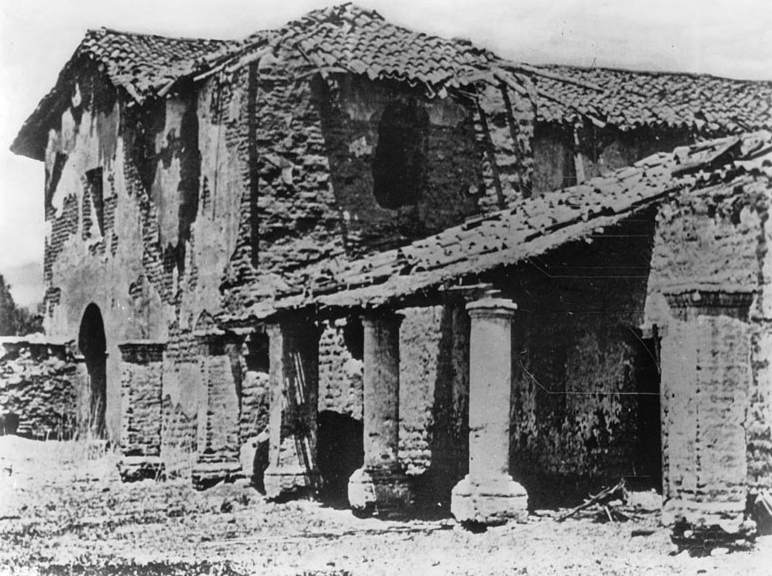 |
|
| (ca. 1875)* - Photograph of the ruins of the front of the church and bell tower of Mission San Fernando, California. The stucco has fallen from most of the adobe brick walls. A series of 4 columns supports the tile roof over them forming a covered patio which is in a state of disrepair. |
.jpg) |
|
| (ca. 1880)* – View showing an Indian woman tending crops at the San Fernando Mission. CSUN/Oviatt Digital Library (SFVHS Archives) |
.jpg) |
|
| (ca. 1880)* - Two Indian women are seen sitting on a wooden bench in front of a building at the San Fernando Mission. CSUN/Oviatt Digital Library (SFVHS Archives) |
.jpg) |
|
| (ca. 1880)* – Close-up view showing an Indian woman standing next to the San Fernando Mission. Photo Credit: CSUN/Oviatt Digital Library (SFVHS Archives) |
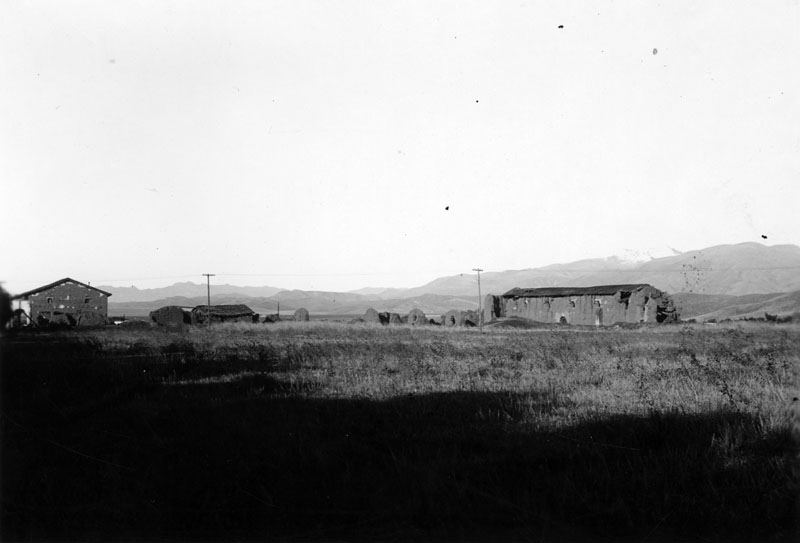 |
|
| (ca. 1884)* - Photograph of the original chapel, circa 1884, prior to being re-roofed by the Landmarks Club; as seen from across the field. Several other structures, most in crumbled ruins, are visible on the left. |
.jpg) |
|
| (ca. 1884)* - View of the original chapel, circa 1884. The only remains of an adjacent structure is a long, crumbling wall. |
 |
|
| (ca. 1884)* - Photograph of the original chapel, circa 1884, prior to being re-roofed by the Landmarks Club. The only remains of an adjacent structure is a long, crumbling wall. |
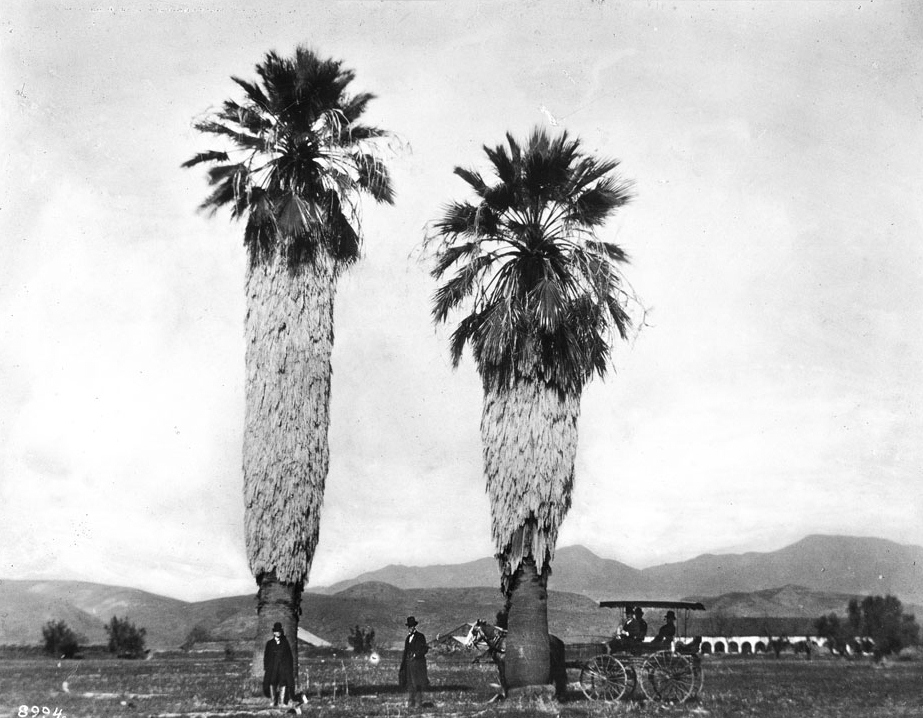 |
|
| (ca. 1886)* - Photograph of the two tall palm trees at the San Fernando Mission, showing a horse and carriage, ca.1886. Two men stand at the base of the two palms, dressed in long coats and hats. To the right, a group sits in a horse-drawn carriage which is shown from the side behind the rightmost palm. In the background to the far right, the arcade of the mission can be seen. Mountains fill the rest of the background. |
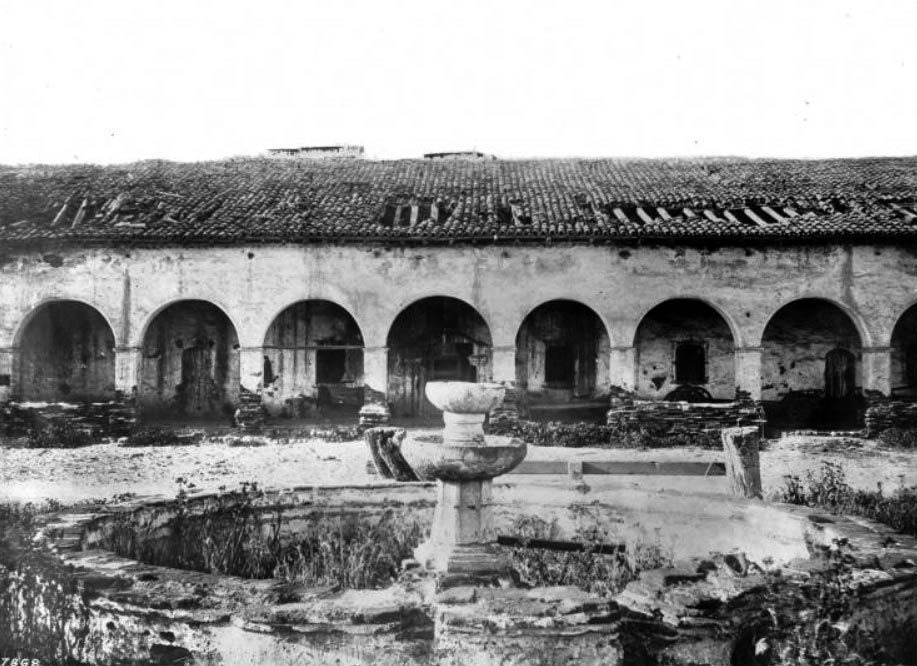 |
|
| (ca. 1880s)* - View of the Mission San Fernando cloister, showing the fountain. The cloister is shown in disrepair, a number of holes in its terracotta-tiled roof and spackle chipping off its wall beyond the archways of the portico. The fountain is pictured in the center foreground, its center overgrown by weeds. |
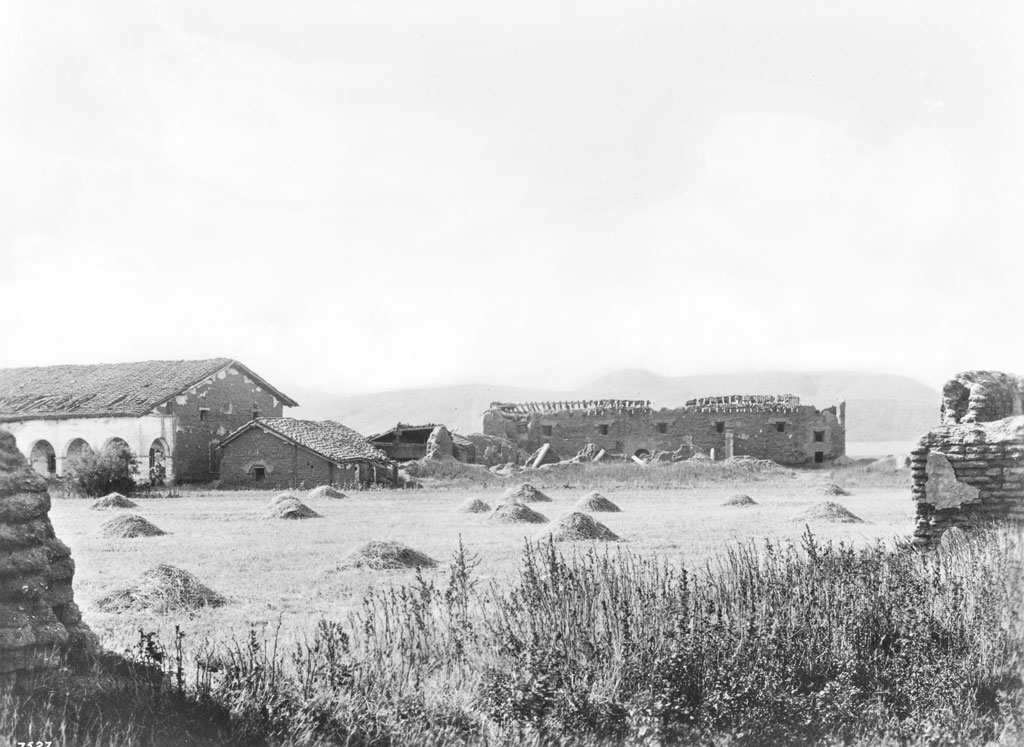 |
|
| (1887)* - Photograph of the ruins of the Mission San Fernando Rey de Espana as seen from the hayfield, 1887. Portions of wrecked adobe wall and hayfield filled with piles of hay stand in the foreground, while the crumbling adobe buildings of the mission are visible along the horizon in the background. A long adobe stands roofless, its beams showing, at center, while a wider adobe to the left longhouse stands with holes in the roof that still remains. A small hut-like adobe stands between them, next to which the remains of an all but demolished adobe stand, the walls having collapsed. Long grass is also visible in the foreground. |
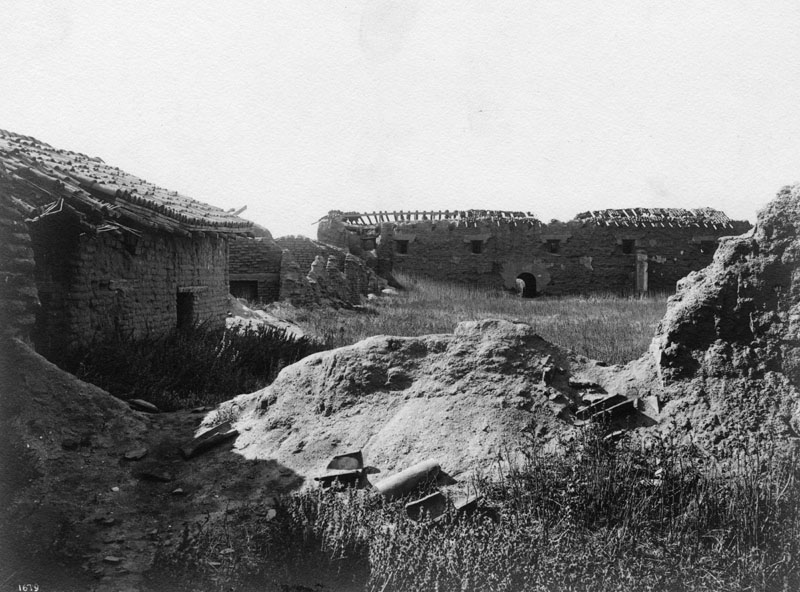 |
|
| (ca. 1887)* - View of the original chapel and surrounding adobe structures in a state of ruin. Photograph shows the rear portion of the crumbling church, its tile roof completely gone. Rubble can be seen on the mounds of dirt in the foreground. |
Historical Notes It was not until 1896 when Charles Fletcher Lummis, a prominent member of the Landmarks Club, began a campaign to reclaim the mission property that the fortunes of San Fernando Mission improved. As president of the "Landmarks Club of Southern California" (an all-volunteer, privately funded group dedicated the preservation of California's deteriorating Spanish missions), Lummis noted that the historic structures "...were falling to ruin with frightful rapidity, their roofs being breached or gone, the adobe walls melting under the winter rains." Lummis wrote in 1895 "In ten years from now—unless our intelligence shall awaken at once—"there will remain of these noble piles nothing but a few indeterminable heaps of adobe. We shall deserve and shall have the contempt of all thoughtful people if we suffer our noble missions to fall." |
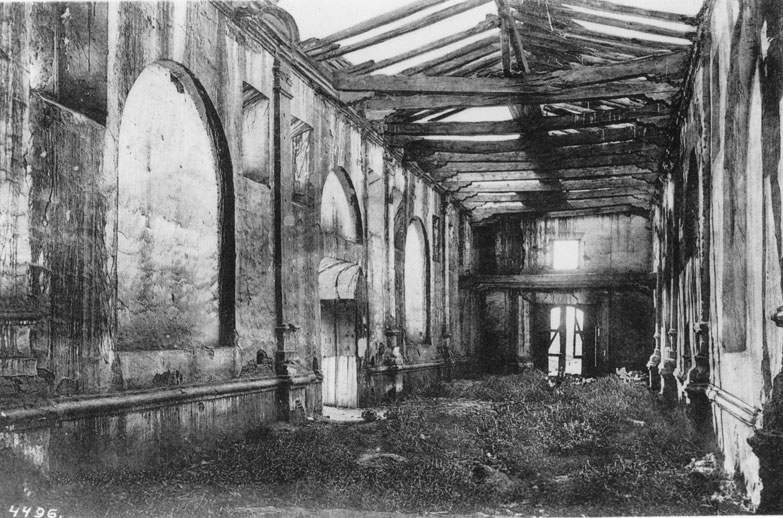 |
|
| (ca. 1890)* - Photograph of the ruins of the interior, looking west toward the main entrance, of Mission San Fernando, ca.1890. Exposed beams and rafters are open to the sky above. Vegetation grows from the dirt floor. Shallow recessed arched alcoves line both walls. |
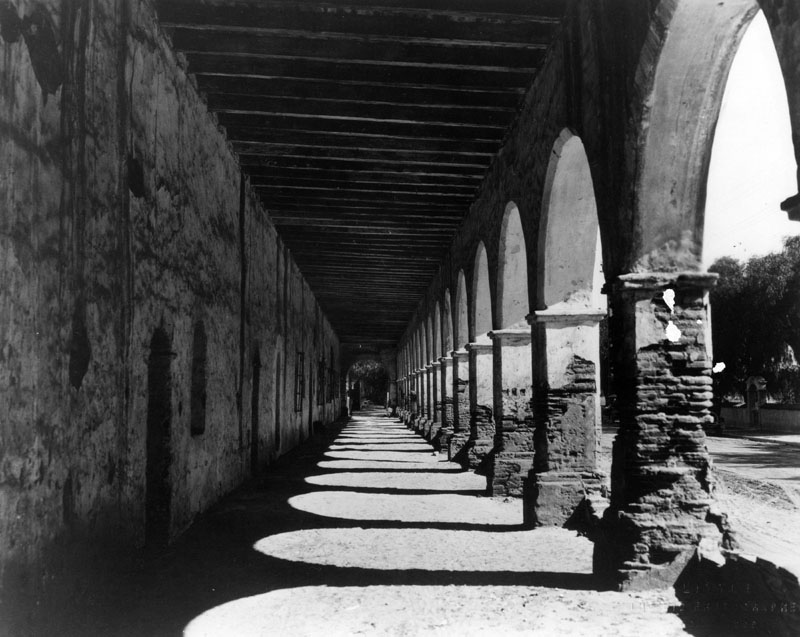 |
|
| (1800s)* - View of the Convento colonnade, or archway, of San Fernando Rey de España Mission. Photograph shows the length of the colonnade, arches, wood beams, and decorative shadows on the floor. The road that would eventually become El Camino Real is visible through the archway on the right. |
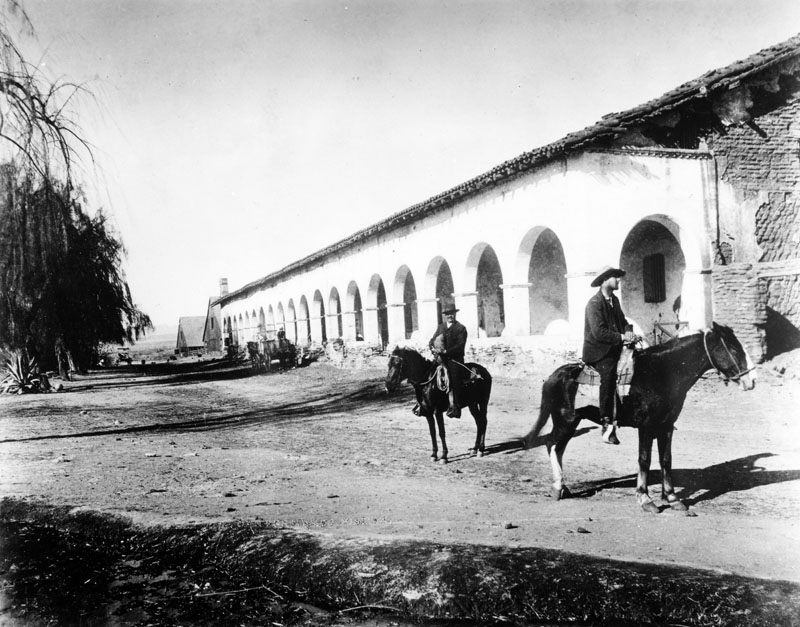 |
|
| (ca. 1880s)* - Caption reads: High traffic in front of San Fernando Rey de España Mission. View of the Convento Building, also known as the "Long Building", as well as two men atop their horses, and a carriage parked along the road that would eventually become "El Camino Real". |
Historical Notes In 1842, gold was discovered on a nearby ranch. The area was overrun with prospectors. A rumor that the missionaries had been prospecting gold for years drew the gold-seekers to the church and they dug up the floor looking for buried treasure. This digging continued into the early 1900s. |
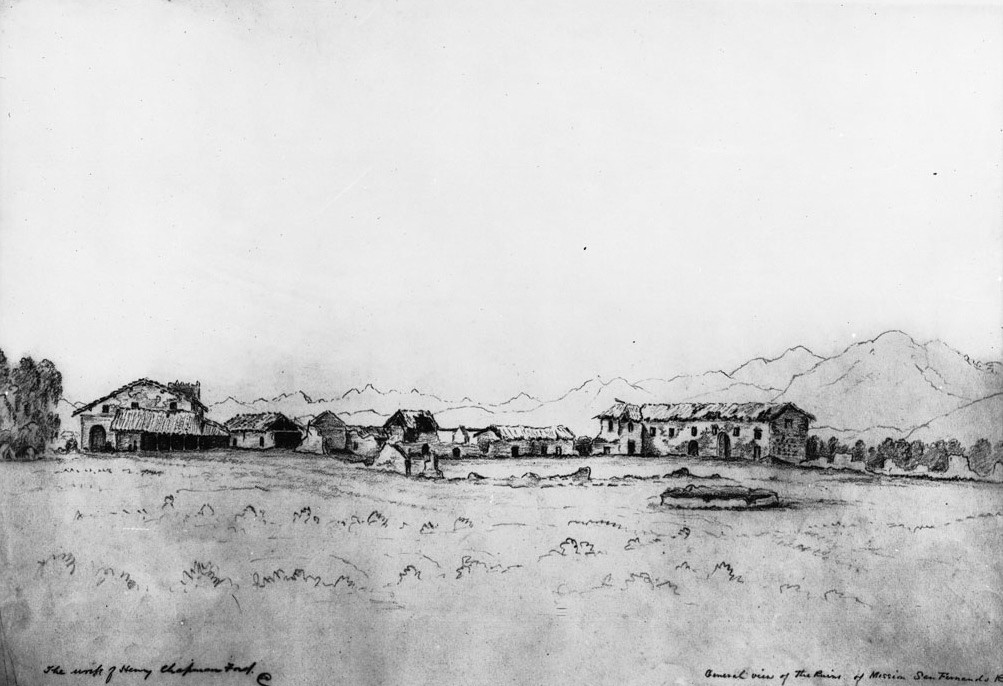 |
|
| (ca. 1883)* - Photograph of a drawing by Henry Chapman Ford showing an external view of the Mission San Fernando Rey de España. The mission buildings are shown in disrepair arranged in a line across the horizon. The tallest adobe stands to the left, two-stories high. A progression of smaller buildings link it with the longest building which ends the line at the far right, also an adobe and two-stories high. A well is pictured in the right foreground while mountains are visible in the distance. |
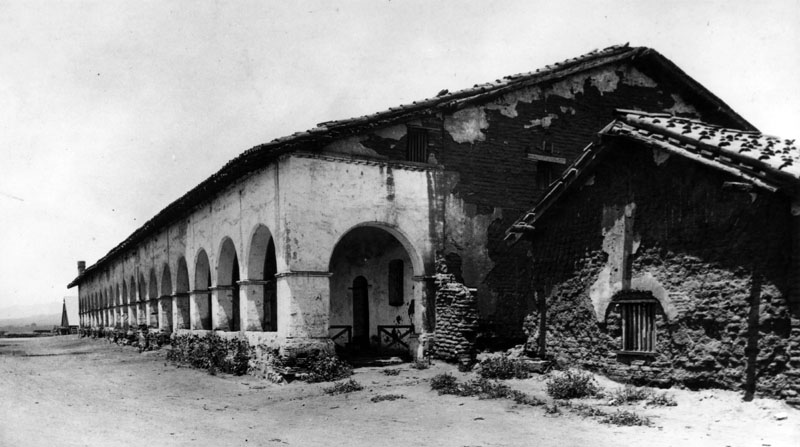 |
|
| (1883)* - View of the Convento Building, also known as the "Long Building", and an adjacent smaller structure as they appeared in 1883. |
Historical Notes The Convento Building is a large two-story building measuring approximately 243 feet long and 50 feet wide, and was built in stages between 1808 and 1822. It has a broad portico extending the whole length of the building, four-foot-thick adobe walls, visible rafters, and a roof of burnt tile. The long portico, sometimes referred to as the colonnade, has 21 Roman arches along the front of the building and is the most recognized image of the Mission. The Convento Building was, and still is, the largest adobe structure in California and is also the largest original building in California's missions. The road that would eventually become "El Camino Real" is visible to the left of the building. |
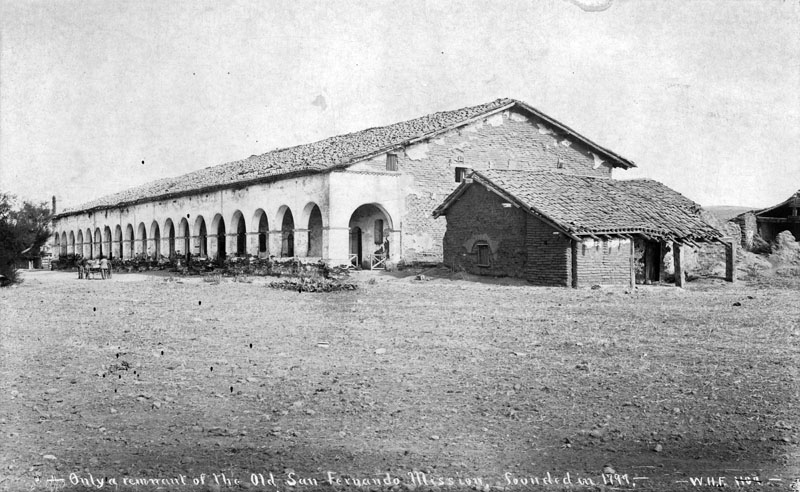 |
|
| (1883)* - Postcard view of the San Fernando Mission in 1883. |
Secularization at San Fernando Mission Starting in the 1830s, the California officials began confiscating mission lands, although they usually left the buildings under the control of the church. From 1834 to 1836, most of the Indians stayed. The rest looked for work in Los Angeles or joined relatives and friends who were still living feely in the nearby hills. In, 1835, Father Ibarra left because he could not tolerate the secularization. |
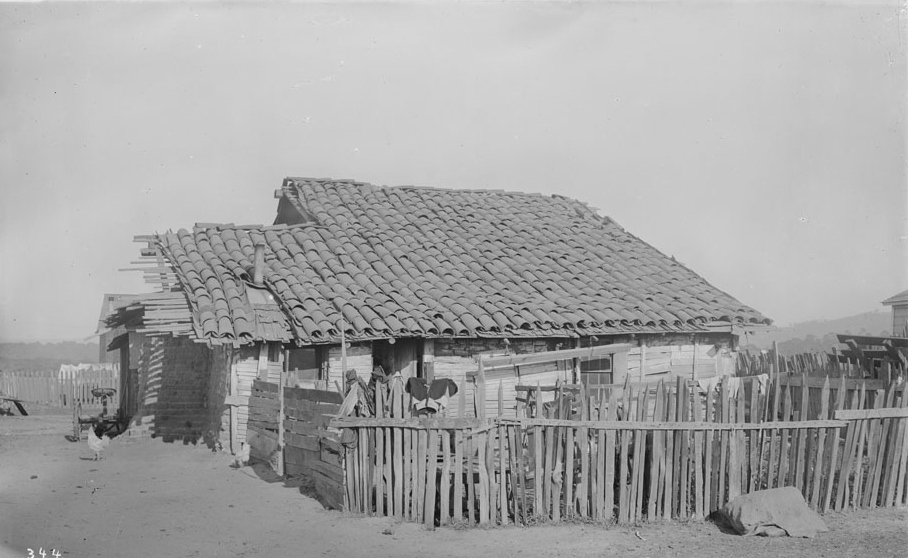 |
|
| (ca. 1884)* - Photograph of Gardener's adobe at Mission San Fernando. The dilapidated old adobe has timbers which extend from beneath the tile roof. The adjacent side yard is surrounded by a rough picket fence. There are two chickens in front of the house. |
Historical Notes The San Fernando Mission was abandoned in 1847. From 1857 to 1861, part of it was used as a stagecoach station. By 1888, the hospice was used as a warehouse and stable, and in 1896, the quadrangle became a hog farm. In 1896, Charles Fletcher Lummis began a campaign to reclaim the property, and conditions improved. |
.jpg) |
|
| (1886)* - View from the corridor of Mission San Fernando Rey de Espana showing its external surroundings and a fountain, Mission Hills, California, 1886. The tall corridor is constructed of wooden beams supporting the roof structure, large arches made of adobe bricks, and stucco to cover the adobe bricks. The structure appears to be in dilapidated condition. A plank lies next to several large rocks (possibly used as a bench) a few yards away to the left. Outside of the corridor is a fountain (at right). Parts of ruined walls are visible in the distance. |
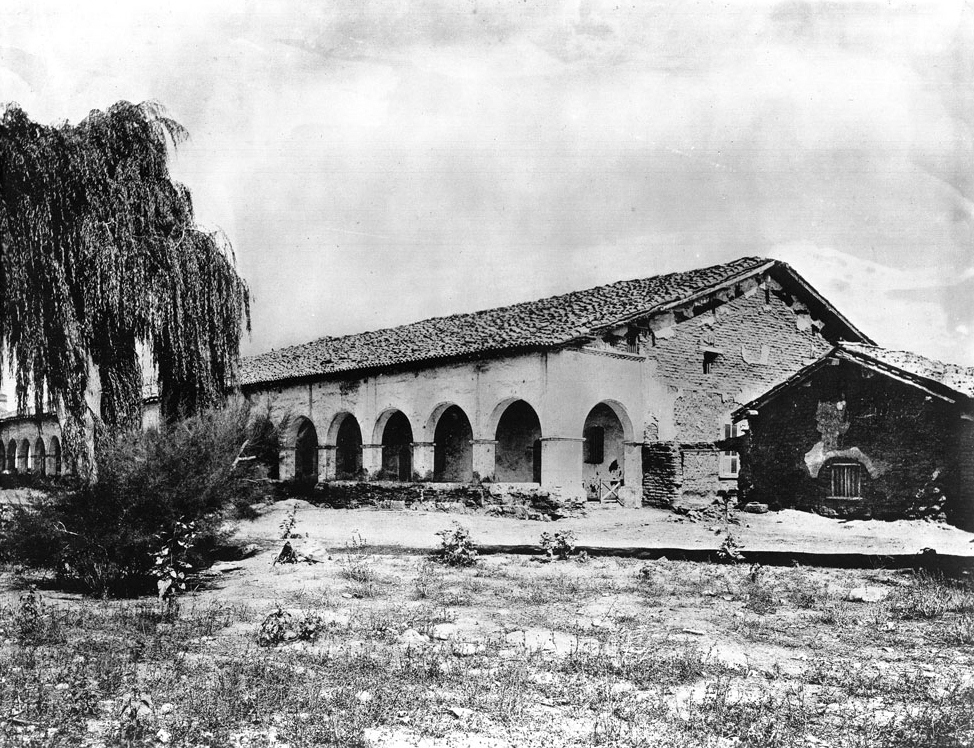 |
|
| (ca. 1886)* - Exterior view of Mission San Fernando Rey de Espana, showing the cloister with a pepper tree in front, Mission Hills, California, ca.1886. The ground appears dry and is covered with wild grass and bushes. |
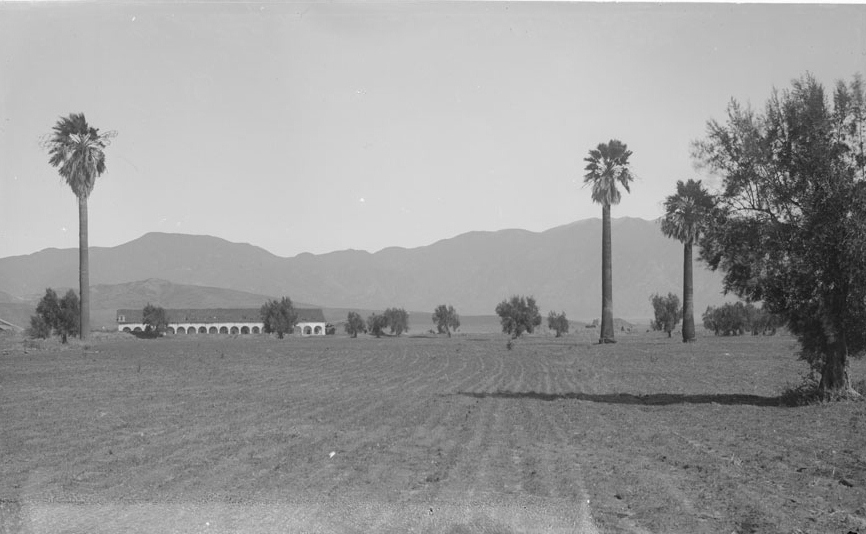 |
|
| (ca. 1887)* - Photograph of cultivated field with a few scattered palm and olive trees with Mission San Fernando Rey de Espana in distance. A long row of white arches are the most predominant feature in this perspective of the mission. Mountains in background. |
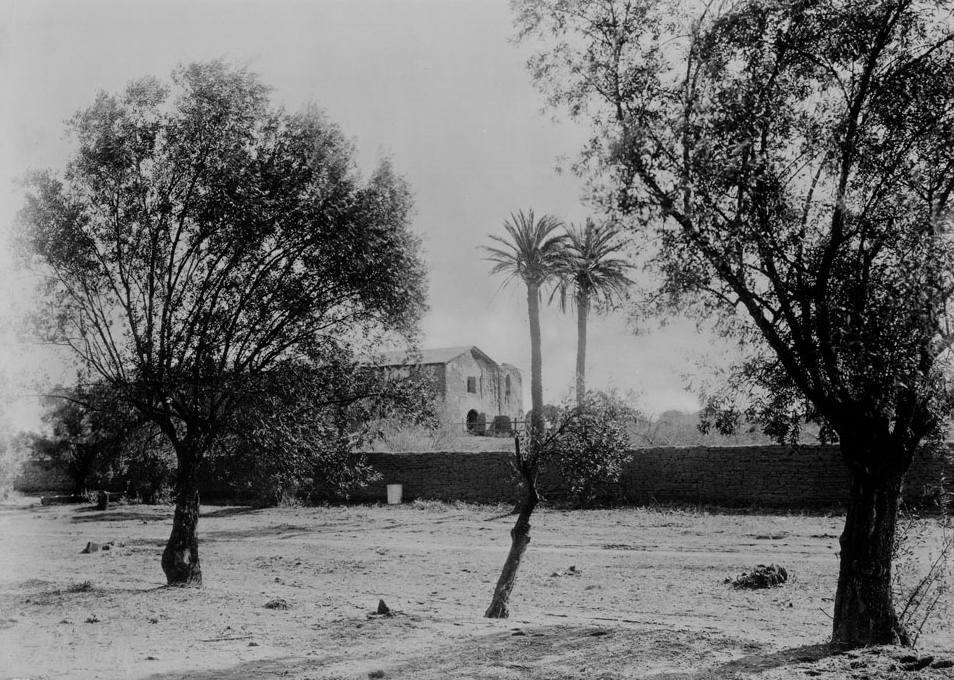 |
|
| (ca. 1890)* - Photograph of a view of the Mission San Fernando Rey de Espana from an olive orchard. Two lush olive trees stand in the foreground to the left and the right, a withered tree standing between them. Farther back, a brick wall separates them from the mission grounds. The mission church can be seen in the center background, a two-story adobe. It features an arched doorway over which a single rectangular window is positioned. A post-and-rail fence is visible along its side. |
 |
|
| (1890s)* - View of Mission San Fernando Rey de Espana, showing the cloister, old gardener's adobe, and ruins of the original chapel. Photo by A. C. Vroman |
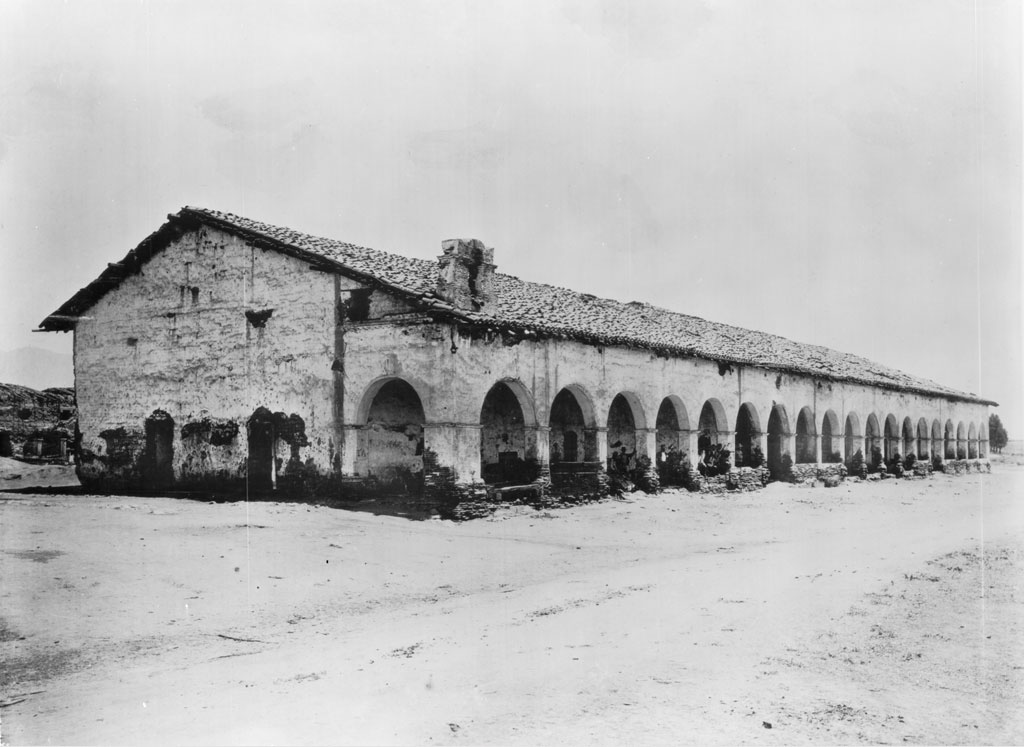 |
|
| (ca. 1890)* - Exterior view of Mission San Fernando Rey de Espana from the west end of the cloister. The mission cloister and building is in dilapidated condition. There are several people standing underneath the cloister peering outward. |
.jpg) |
|
| (ca. 1890s)* – View looking north showing the San Fernando Mission behind mature palm trees. Photo by A. C. Vroman |
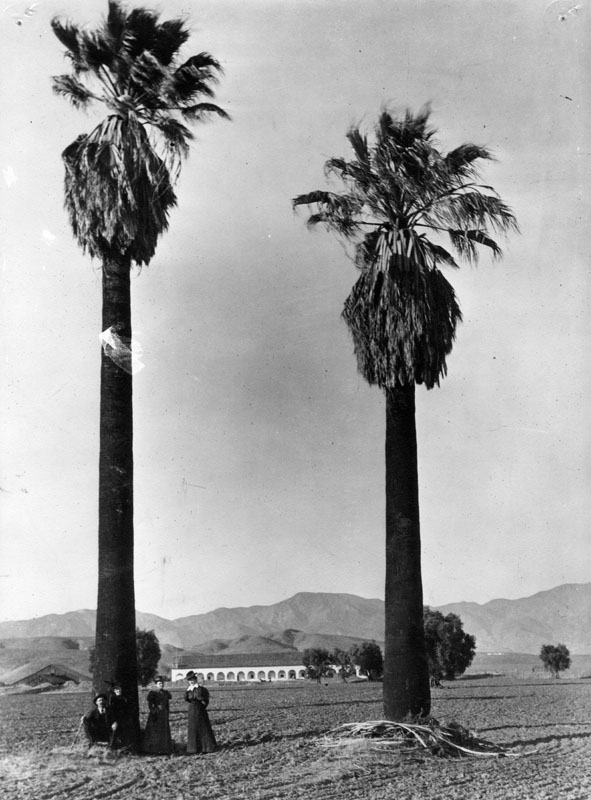 |
|
| (1890)* - View of the Convento Building, also known as the "Long Building" and the palm and olive trees that were planted by the padres. Photograph also shows four people dressed in dark clothing, standing at the base of the left palm. |
Historical Notes The Convento Building was, and still is, the largest adobe structure in California and is also the largest original building in California's missions. California's eighteenth century Franciscan missionaries were the first to plant palms ornamentally, perhaps in reference to the tree's biblical associations. But it was not until Southern California's turn-of-the-twentieth-century gardening craze that the region's leisure class introduced the palm as the region's preeminent decorative plant. Providing neither shade nor marketable fruit, the palm was entirely ornamental. |
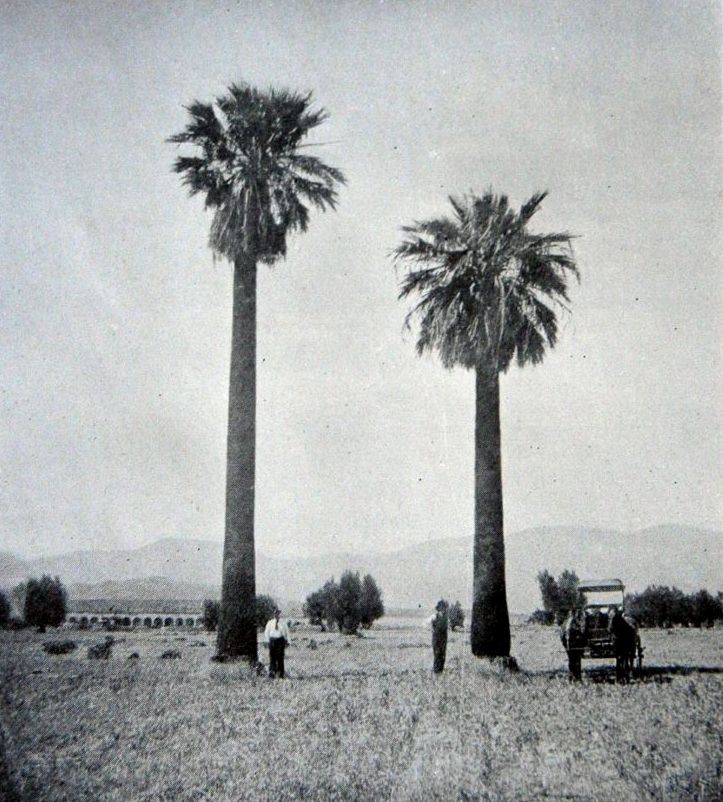 |
|
| (1896)^# - "The Palms of San Fernando" (title at the bottom) from the December 1896 issue of "The Land of Sunshine". This was from an article on the San Fernando Mission Ruins, the monastery of which can be seen in the background. |
Historical Notes Despite the diversity of palms in the Los Angeles area today, only one species—Washingtonia filifera, the California fan palm—is native to California. All of L.A.'s other palm species, from the slender Mexican fan palms that line so many of today's L.A. boulevards to the feather-topped Canary Island date palm, have been imported. |
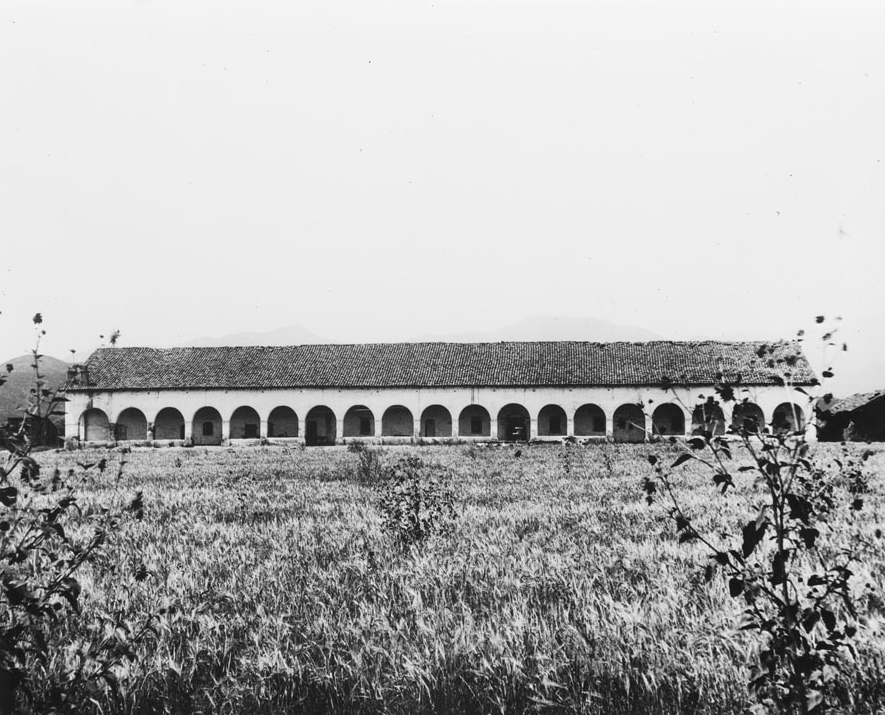 |
|
| (1898)* - Exterior view of the San Fernando Mission cloister. The long, one-story building of the cloister is pictured at center, showing its broad side. A colonnade is effected along the side by the situation of evenly spaced arches, which coincide with what appear to be the doors to the monks' quarters on the main building just inside the colonnade. Three tall, weed-like plants stand in the foreground in a large swath of sedgegrass. The picture file card identifies them as "Sunflowers". |
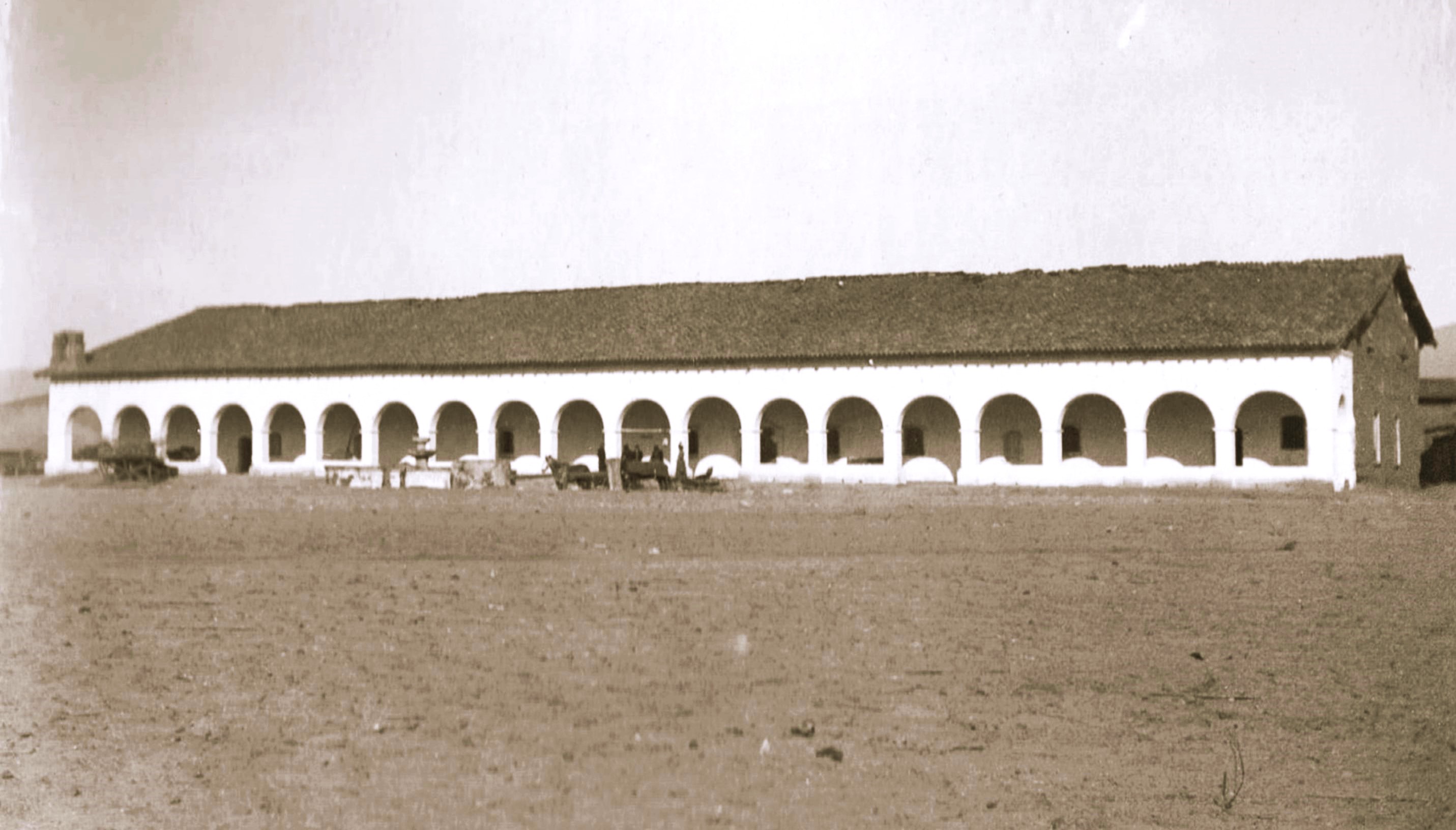 |
|
| (1899)* - Horse-drawn wagon in front of the San Fernando Mission. Photo courtesy of the Altadena Historical Society |
.jpg) |
|
| (1899)* - A group of people pose for the camera in front of the 'Long Building' at the San Fernando Mission. Photo courtesy of the Altadena Historical Society |
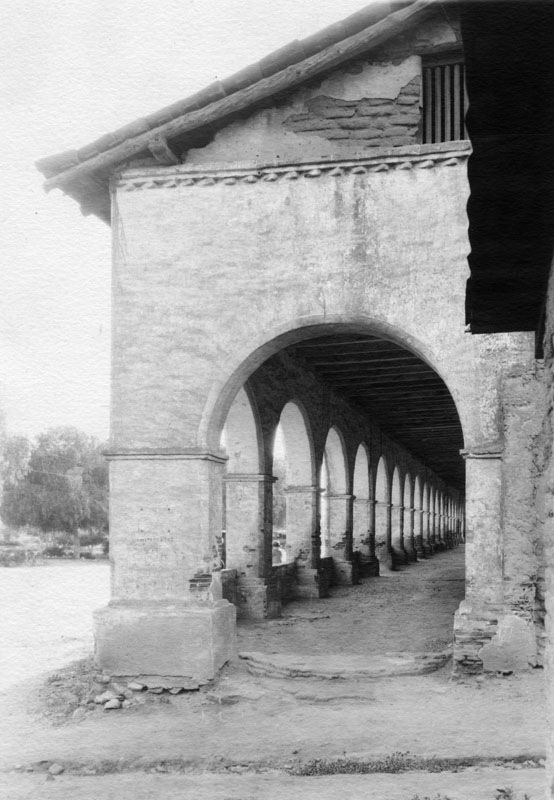 |
|
| (Late 1800s)* - View of the Convento colonnade, or archway, of San Fernando Rey de España Mission. Photograph shows the length of the colonnade, arches, and wood beams. |
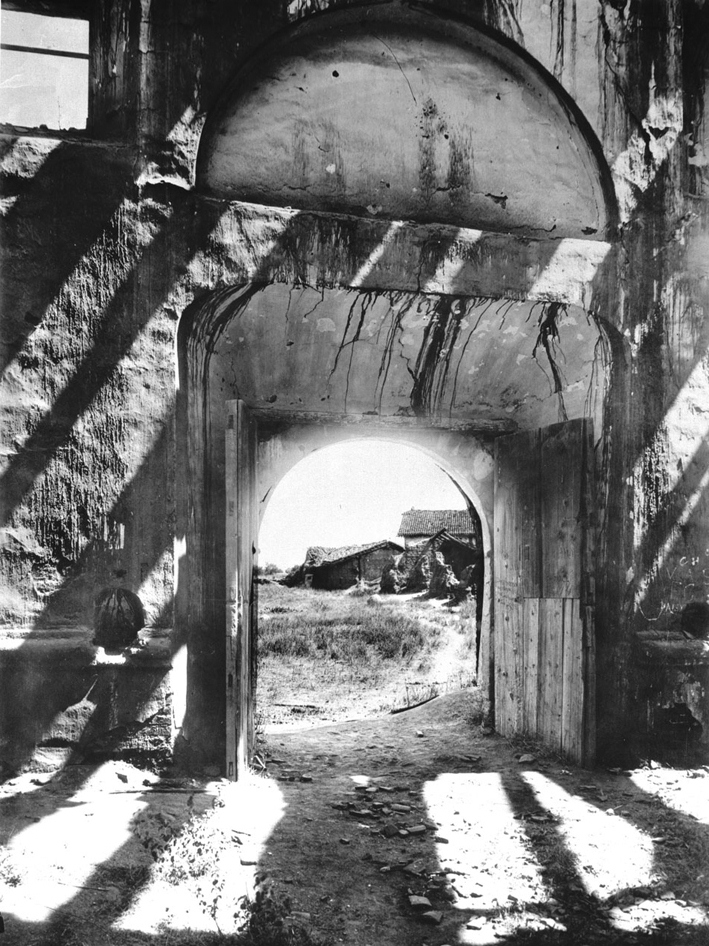 |
|
| (1898)* - Photograph looking through the south door of the ruins of the church of Mission San Fernando, California, 1898. Part of two ruined buildings are visible through the opening. The striped pattern of shadows on the walls and dirt floor of the inside of the church can be seen. |
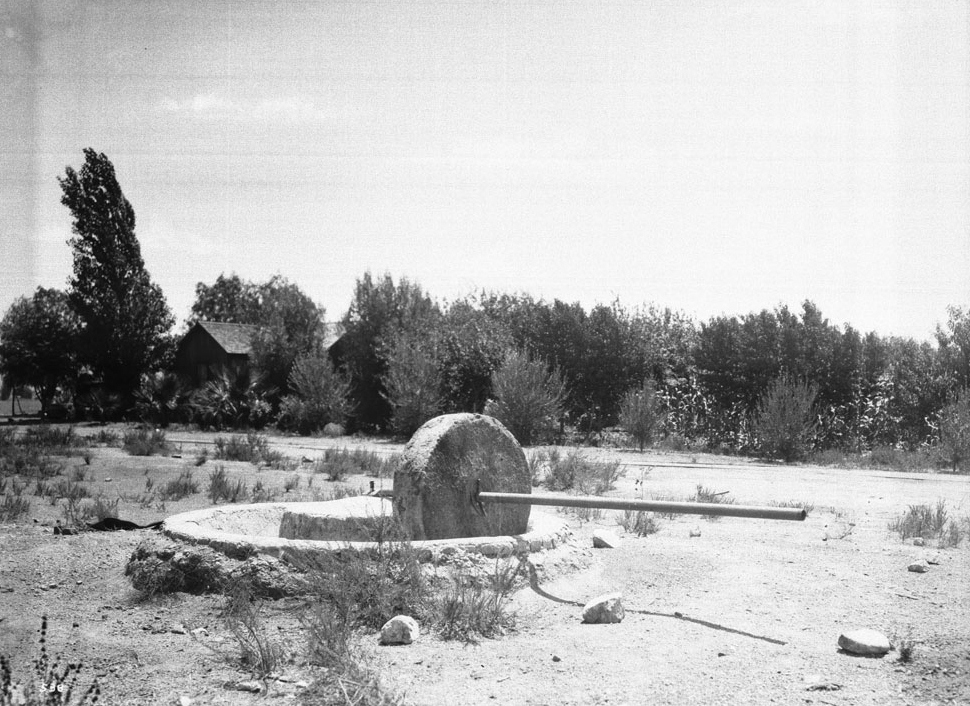 |
|
| (ca. 1898)* - View of the olive mill at the San Fernando Mission, California. A long wooden post extends from the large stone wheel. A building is visible in the background among the foliage. |
 |
|
| (1900)* - A partial view of the original chapel of San Fernando Rey de España, which appears to be intact, as well as an old, crumbling adobe wall adjacent to it. The photograph was taken from inside another structure and shows an arched frame in the forefront. |
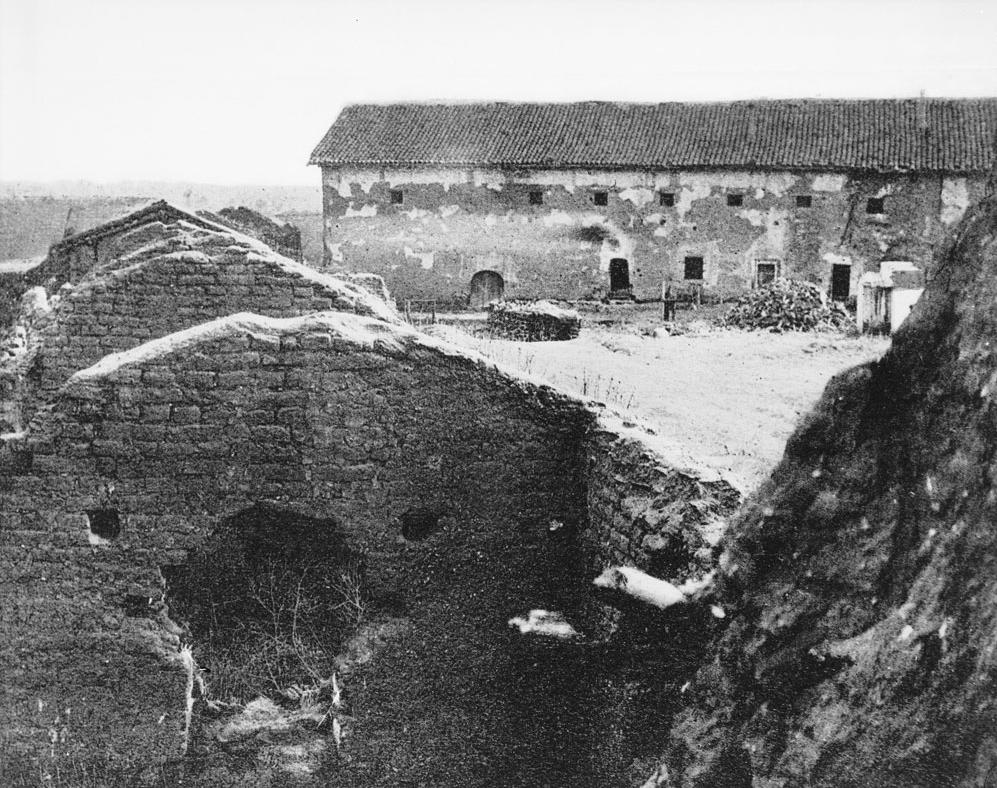 |
|
| (ca. 1900)* - Photograph of the ruins of workshops, viewed from the church looking toward the cloister, at Mission San Fernando, California, ca.1900. The cloister, with tile roof, is still standing, though stucco has fallen off the walls; while the workshops, in the foreground, no longer have roofs. |
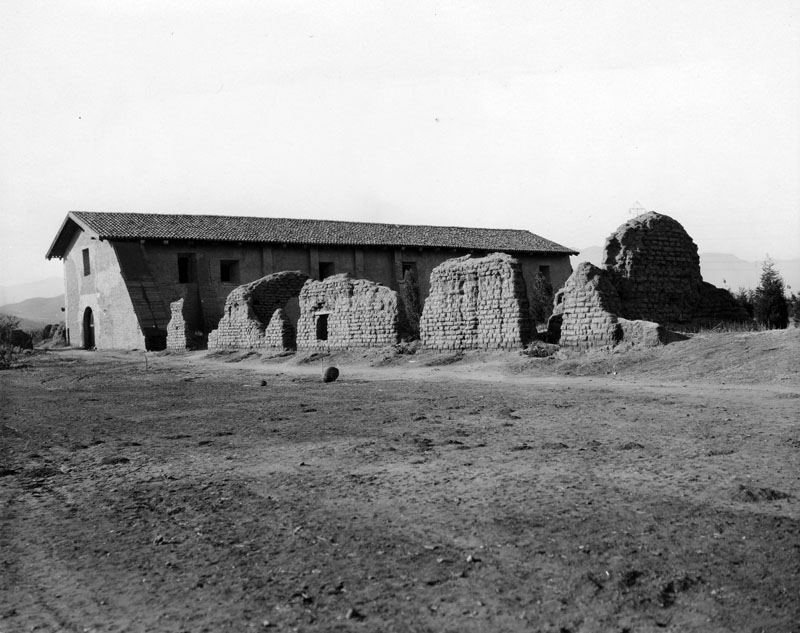 |
|
| (1900)* - A partial view of the original chapel of San Fernando Rey de España, which appears to be intact, as well as an old, crumbling adobe wall adjacent to it. The surrounding area looks deserted. Information on verso reads: "Isaac N. Van Nuys ranch house, circa 1882. His son, J. Benton was a member of Executive Committee of Security First National Bank". It is unclear which structure was Van Nuys' ranch house. |
Historical Notes In 1845, Governor Pío Pico declared the Mission buildings for sale and, in 1846, made Mission San Fernando Rey de España his headquarters as Rancho Ex-Mission San Fernando. The Mission was utilized in a number of ways during the late 19th century: north of the mission was the site of Lopez Station for the Butterfield Stage Lines; it served as a warehouse for the Porter Land and Water Company; and in 1896, the quadrangle was used as a hog farm. San Fernando's church became a working church again in 1923 when the Oblate priests arrived.*^ |
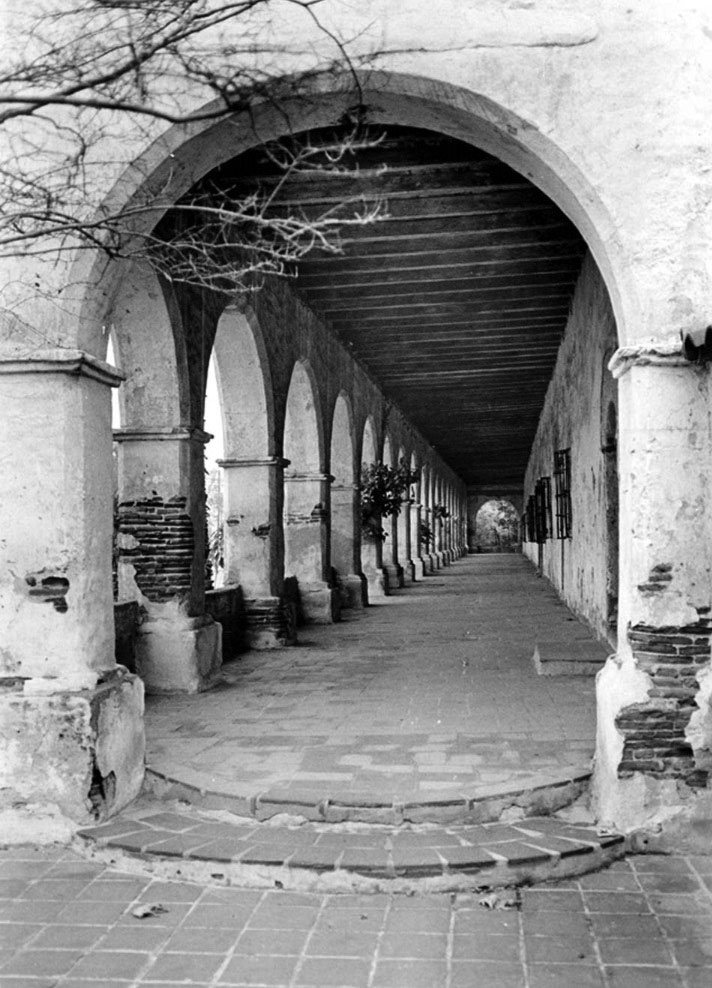 |
|
| (1897)^* - The Convento Building at San Fernando, Rey de Espana Mission as it existed in 1897. Timber roof supports are visible. Donor: Milt Fries. |
 |
|
| (ca. 1900)* - View of the cloister of Mission San Fernando looking west. The colonnade of the cloister is shown to the left, with the doors to the monks' quarters shown at right. Each door is arched and cut into the adobe walls of the facility, as well as flanked by two bar-protected windows. What appears to be an amassment of furniture or machinery is seen at the end of the corridor, dimly lit just before the terminal arch opens out to the rest of the mission. A winding dirt path can be seen cutting its way through grass just outside the colonnade. |
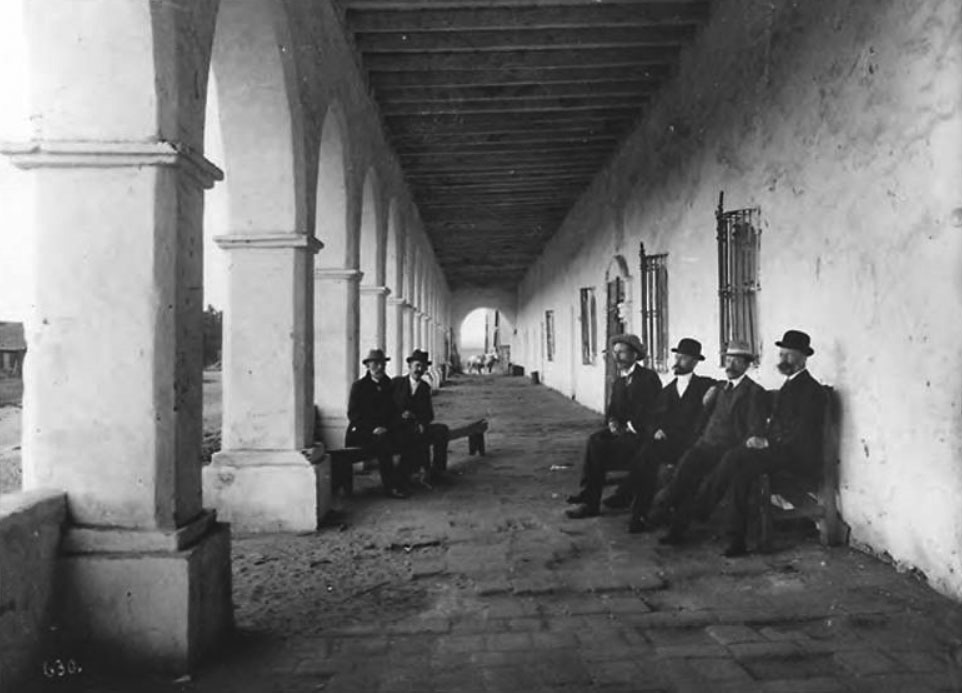 |
|
| (ca. 1900)* – Photo titled “The Club and Friends” showing six men sitting on benches under the shade of the Convento colonnade. Photo by A. C. Vroman |
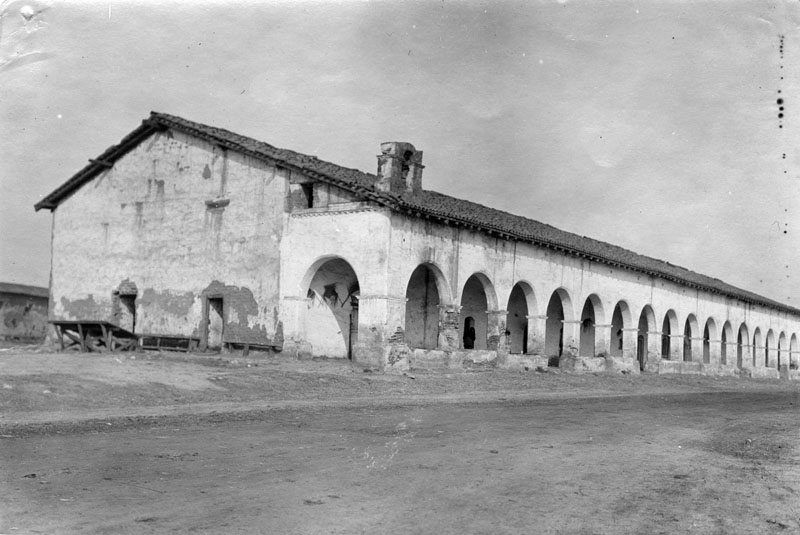 |
|
| (ca. 1903)* - View of the Convento colonnade, or archway, of San Fernando Rey de España Mission. |
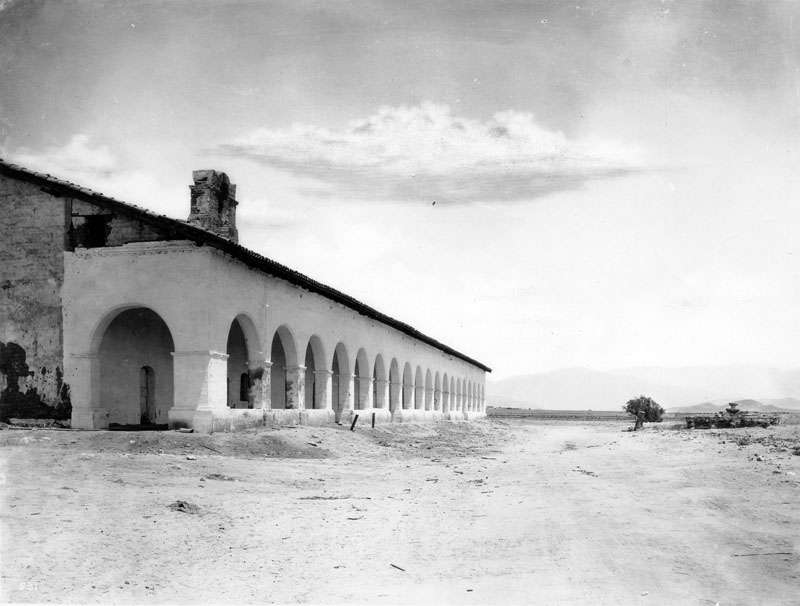 |
|
| (ca. 1903)* - Early view of the Convento Building, also known as the "Long Building", as it appeared in the early 1900s. The dirt road that parallels the structure is completely barren as far as the eye can see, except for a fountain and small tree across the way on the right; this road would later become "El Camino Real". |
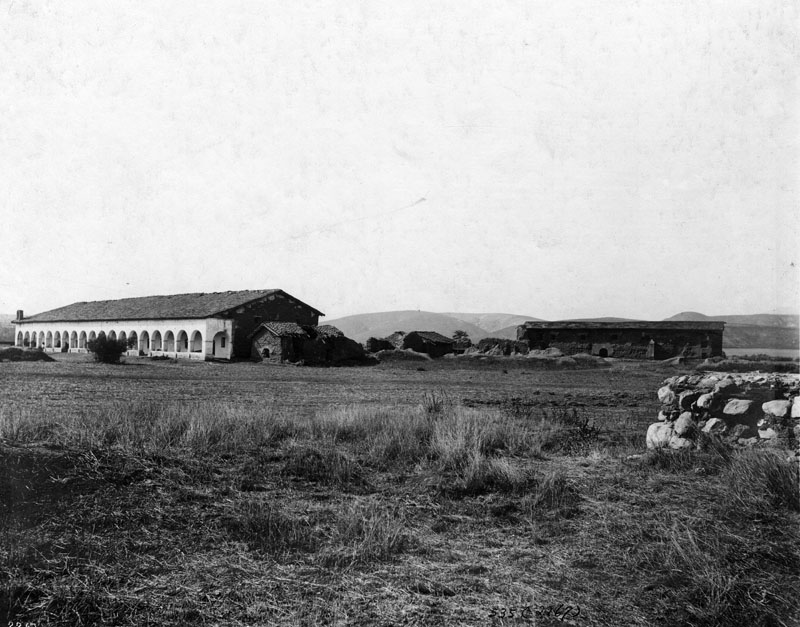 |
|
| (ca. 1903)* - View of the Convento Building, also known as the "Long Building" (on the left), after its 1903 restoration, as well as the original chapel structure (on the right), which had since fallen into ruin. |
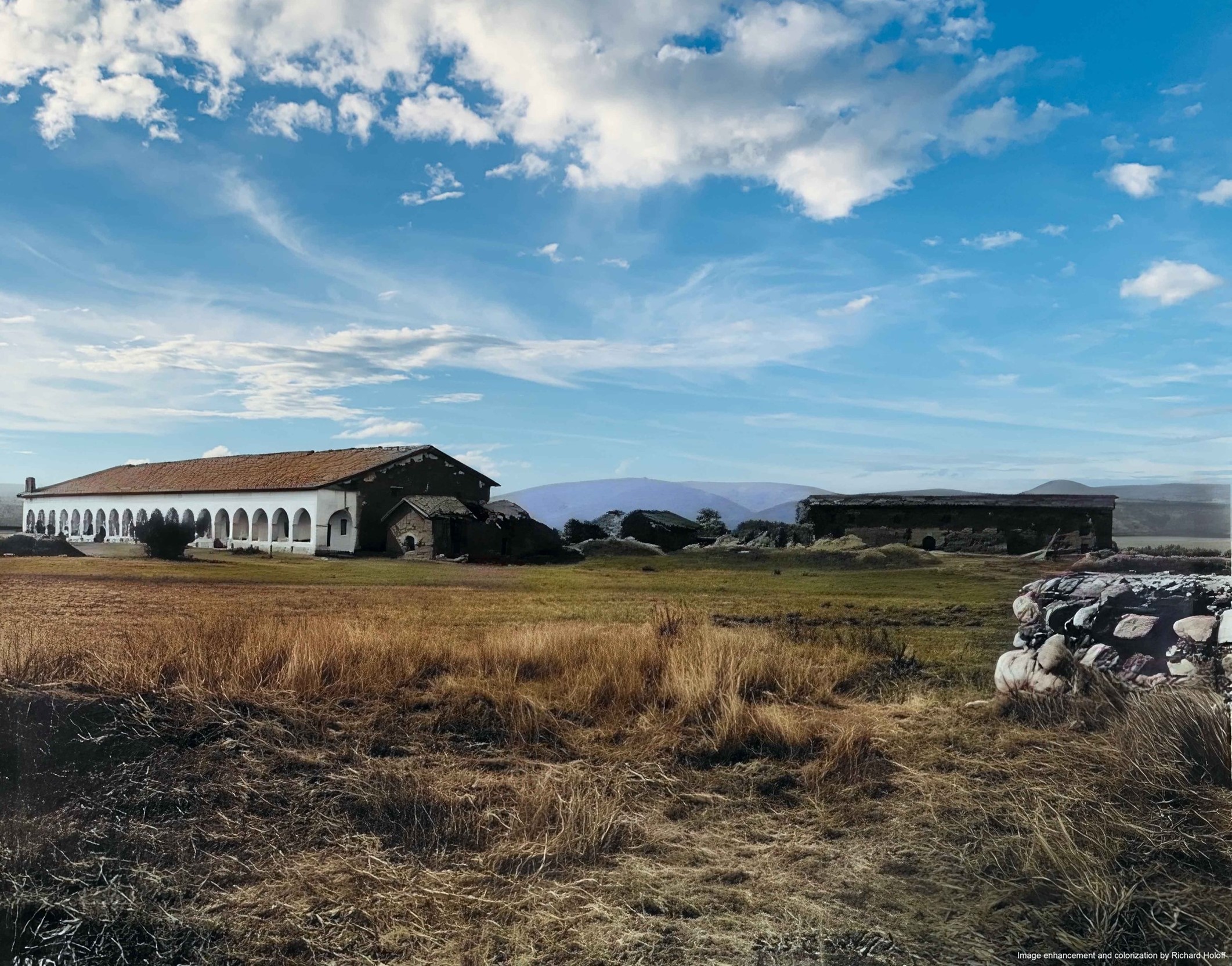 |
|
| (ca. 1903)* - View of the Convento Building, also known as the "Long Building" (on the left), after its 1903 restoration, as well as the original chapel structure (on the right), which had since fallen into ruin. Image enhancement and colorization by Richard Holoff. |
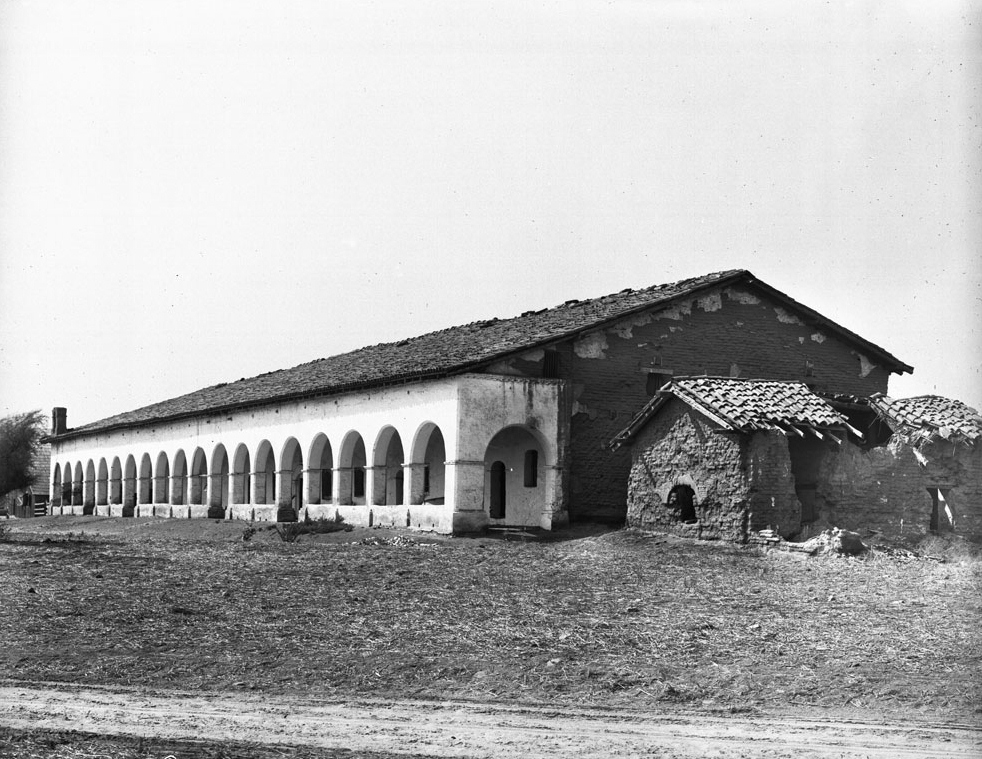 |
|
| (1904)* - Photograph of the cloister of Mission San Fernando, California, from the southeast. A long row of arches supports the roof over the exterior corridor on the left side of the building. Part of the tile roof has fallen in on the building at the end (right) of the main building. A dirt road or path runs across the foreground. The primary vegetation is scrub grass and scrub brush. |
 |
|
| (1909)* - Clear view of Mission San Fernando with rolling hills in background. |
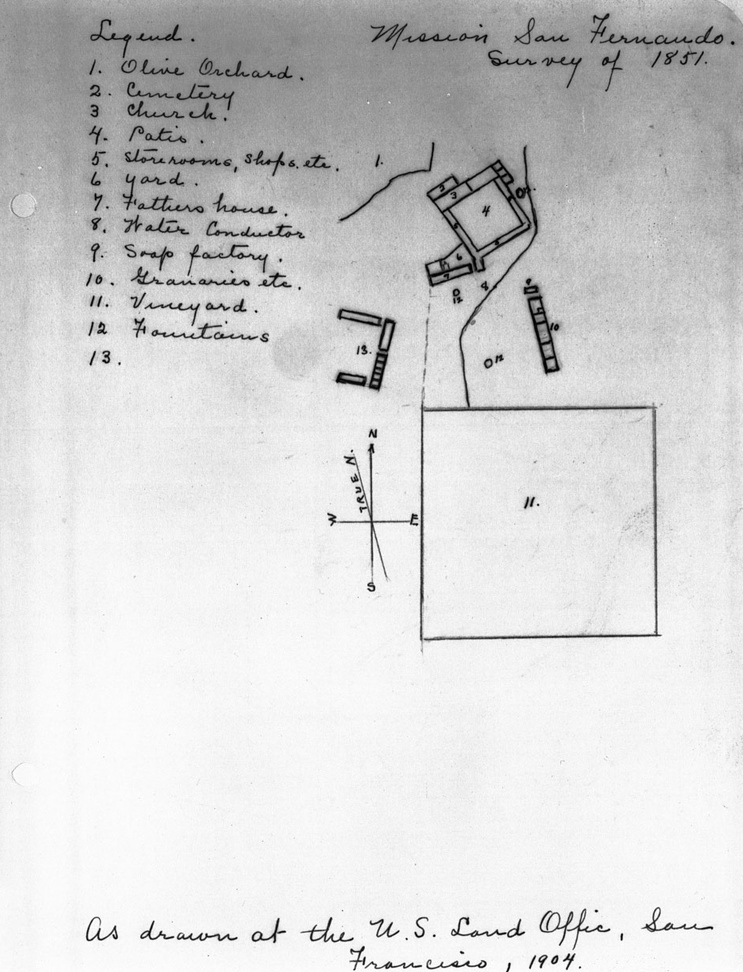 |
|
| (1904)* - Photograph of a surveyor's map of the Mission San Fernando Rey de Espana, 1904. The document, drawn at the U.S. Land Office of San Francisco in 1904 from an 1851 survey, shows a square and other aerial polygons to the right, labeled with numbers. To the left, the numbers are identified by the following names: "1. Olive Orchard", "2. Cemetary", "3. Church", "4. Patio", "5. Storerooms, shops, etc.", "6. Yard", "7. Fattiero House", " 8. Water Conductor", "9. Soap factory", "10. Graineries, etc.", "11. Vineyard", "12. Fountains". Number thirteen is left blank, although it has a corresponding number on the map. A compass rose which includes true north is also shown. |
 |
|
| (ca. 1907)* – Panoramic view showing the Convento Building of the San Fernando Mission. Library of Congress |
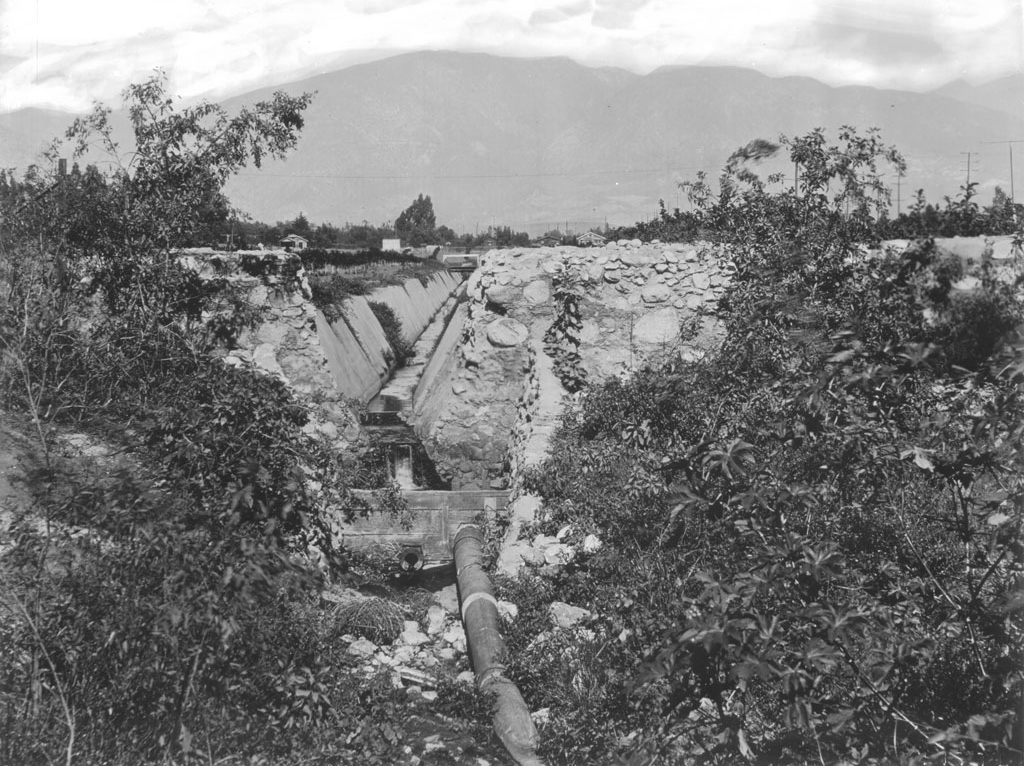 |
|
| (1910)* - View of the small canal and waterpipe to the water supply of the San Fernando Mission. Visible from between two areas of brush, a pipe runs to a barrier made out of planks, beyond which a concrete canal filled with water flows, flanked to either side by bedrock. |
Historical Notes Several springs provided abundant water and a vast irrigation system supplied the mission and its lands. |
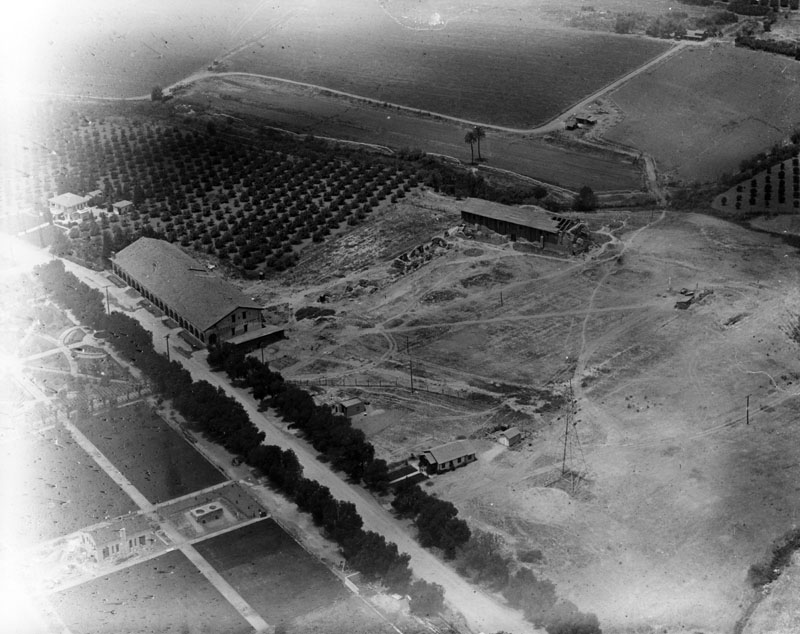 |
|
| (Early 1900s)*- Aerial view of the original chapel structure (upper right) as well as the Convento Building (middle left), and its surrounding land. Photograph shows a small section of Brand Park across from the Convento; a plowed field between the Convento and chapel, which is possibly an orchard; and a large, empty dirt field on the right, as well as in the background. The road that would eventually become "El Camino Real" runs parallel to the Convento and is visible on the left, lined with numerous trees. |
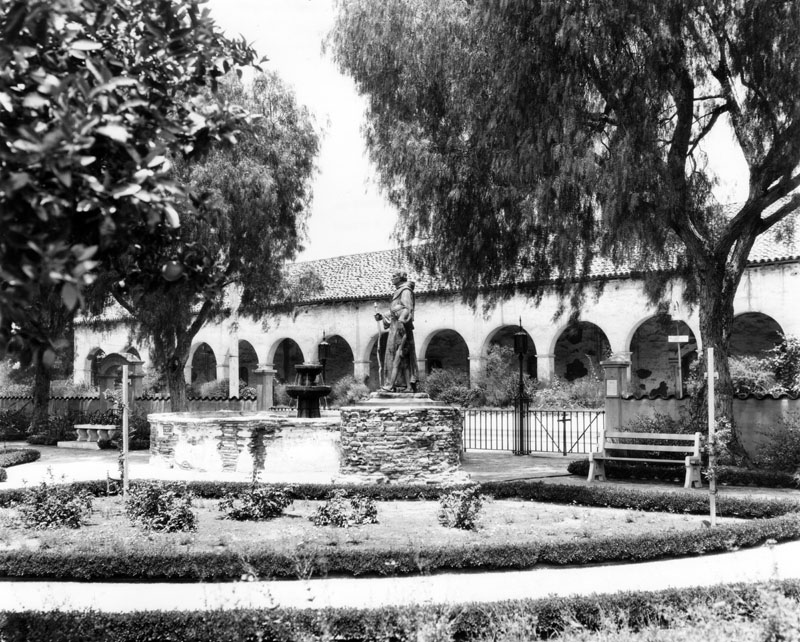 |
|
| (Early 1900s)* - Brand Park is a beautiful and spacious park located at 15174 San Fernando Mission Boulevard, across the street from Mission San Fernando Rey de España. It features an old soap works, the original mission fountain - which now stands some 30 feet from its first location and shows significant signs of deterioration, and a large and oddly shaped reservoir from which the mission fathers were supplied with water. At the entrance to Brand Park is Barnham's life-sized statue of Father Junípero Serra, with his arm around an Indian boy. Various trees and plants cover the grounds in this courtyard, where bullfights were once held. |
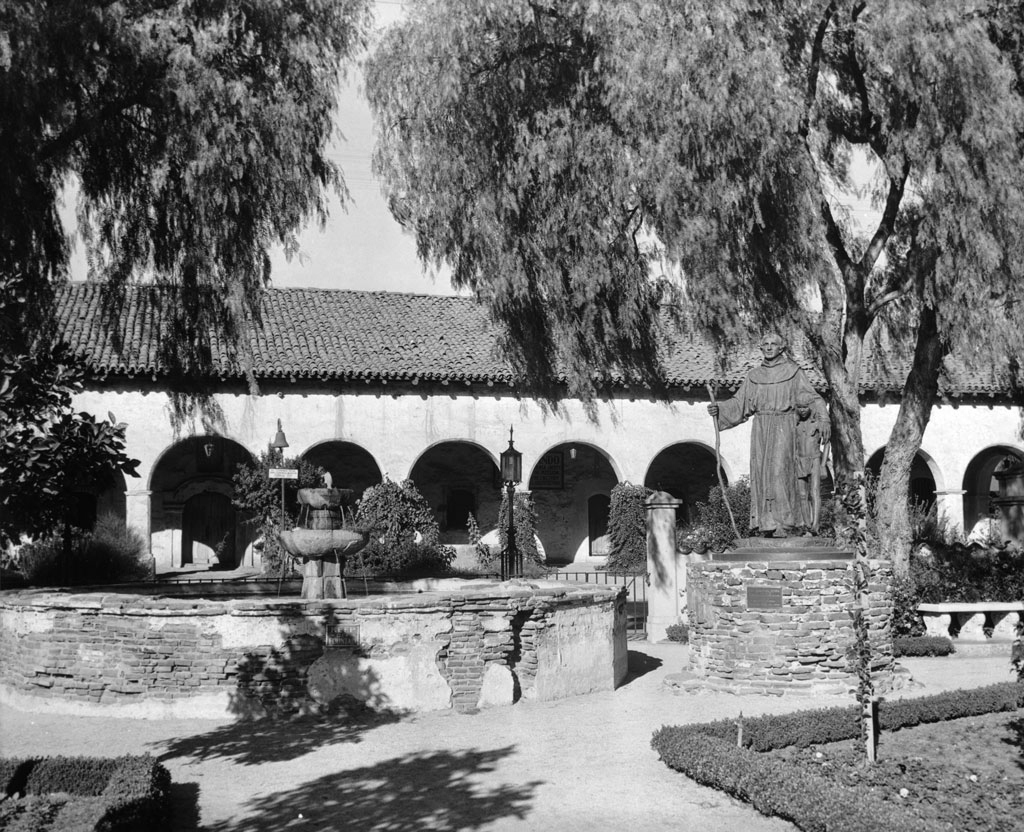 |
|
| (Early 1900s)* - Photograph of a view of the inner courtyard at Mission San Fernando Rey de Espana, showing a statue and a fountain, ca. 1900. The fountain can be seen in the foreground at left and consists of a large circular pool made from adobe bricks and a two-tiered fountain in the middle. At right, a statue of a missionary stands on an adobe base. The walls and adobe archways of the mission can be seen in the background. The roof of the mission is made from terracotta tiles. Two large trees can be seen in the courtyard. |
.jpg) |
|
| (ca. 1920s)* - This photograph shows an unidentified woman sitting on the ledge of the original mission fountain - which now stands some 30 feet from its first location. Curiously enough, she sits next to the sign that clearly reads: "Keep Off Fountain". Also featured, but not visible in this shot, is an old soap works, a large and oddly shaped reservoir from which the mission fathers were supplied with water. |
 |
|
| (ca. 1920s)* - View of the Convento colonnade, or archway, of San Fernando Rey de España Mission. Photograph shows the length of the colonnade, arches, wood beams, and decorative shadows on the floor. A bell marker identifying El Camino Real is visible through the second archway. The placing of markers (bells) for Camino Real began in 1904. |
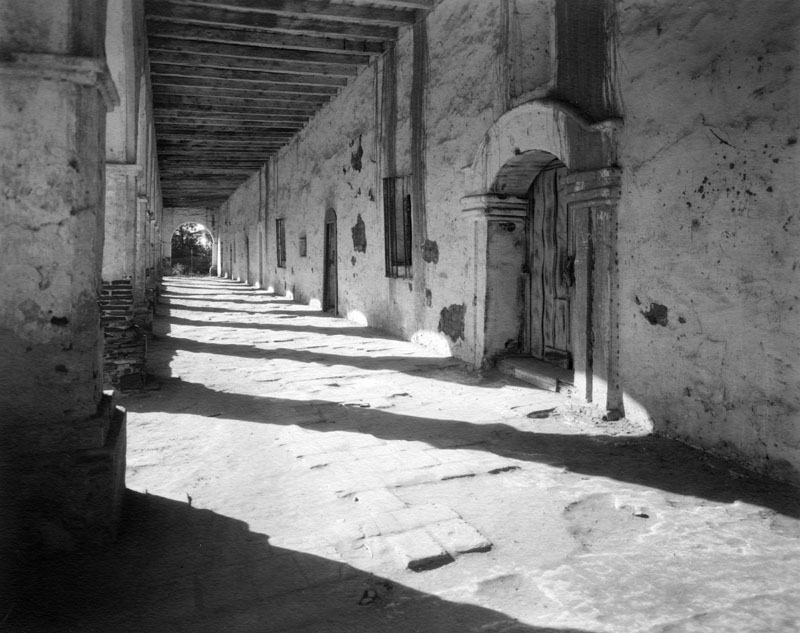 |
|
| (ca. 1920s)* - View of the Convento colonnade, or archway, of San Fernando Rey de España Mission. Photograph shows the length of the colonnade, arches, wood beams, and several arched doors and windows. |
 |
|
| (ca. 1920s)* - View of the Convento Building, also known as the "Long Building", and an automobile parked along the road that would eventually become "El Camino Real". The Convento Building is a large two-story building measuring approximately 243 feet long and 50 feet wide, and was built in stages between 1808 and 1822. It has a broad portico extending the whole length of the building, four-foot-thick adobe walls, visible rafters, and a roof of burnt tile. |
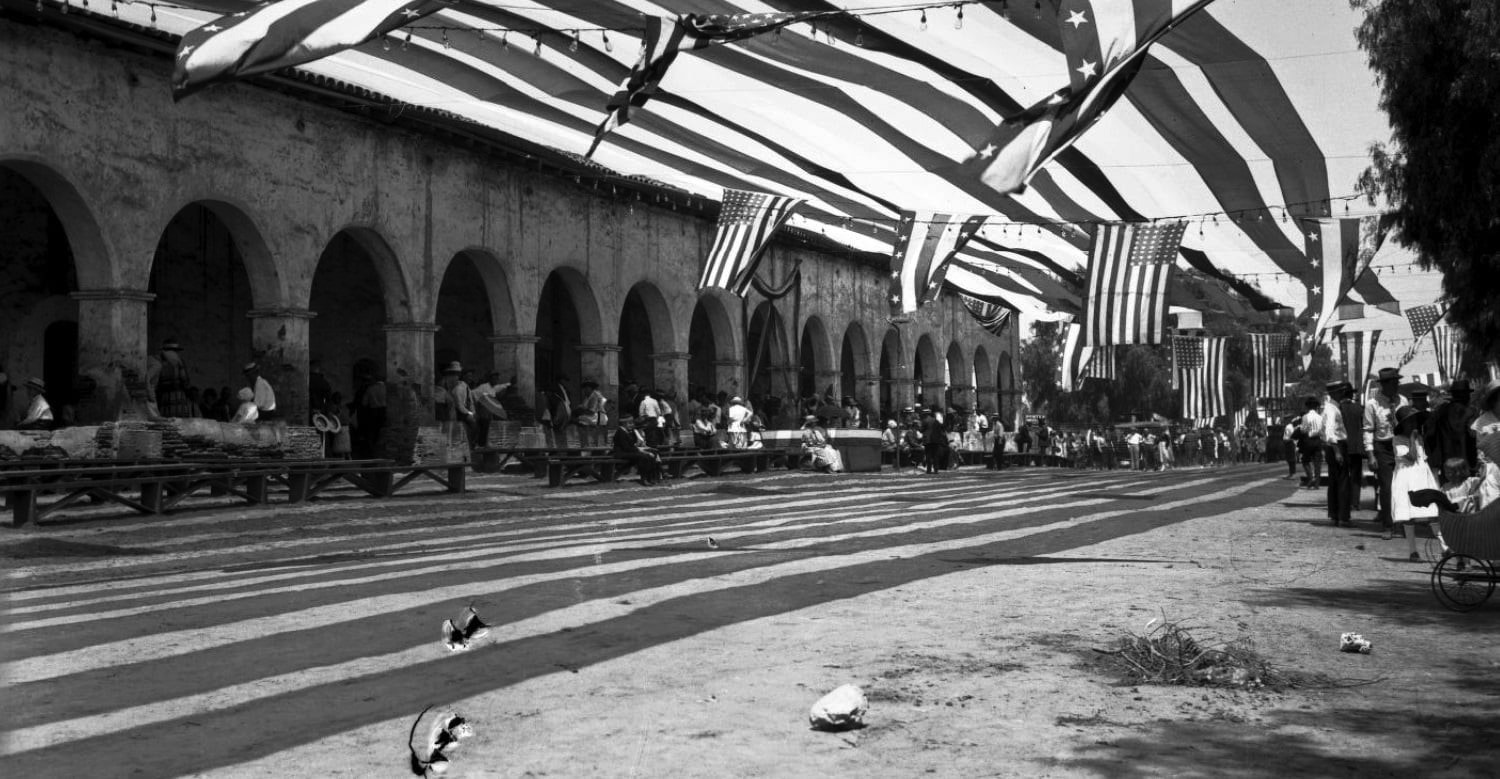 |
|
| (1922)* - Fourth of July celebration at Mission San Fernando Rey de España. LA Times Photo |
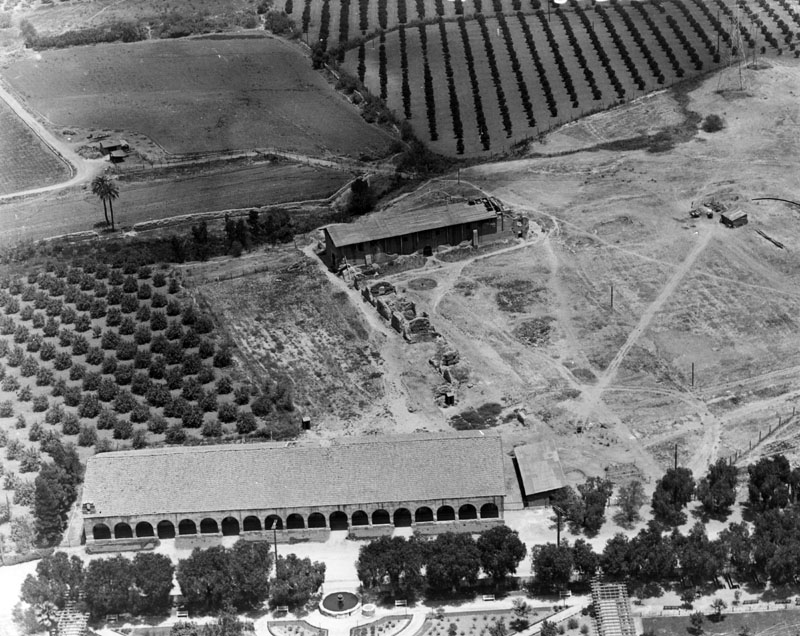 |
|
| (ca. 1920s)* - Aerial view of the original chapel structure (middle) as well as the Convento Building (bottom), and its surrounding land. Photograph shows a small section of Brand Park and its fountain across from the Convento; a plowed field behind the Convento and another behind the chapel, which appear to be orchards; and a large, empty dirt field on the right, as well as at upper left. The road that would eventually become "El Camino Real" runs parallel to the Convento and park, and is lined with numerous trees. |
San Fernando Mission in the 20th Century In 1923, San Fernando Mission became a church again, and the property was turned over to the Oblate fathers. Restoration proceeded steadily, but an earthquake in 1971 damaged the original buildings beyond repair. An exact replica was completed in 1974. More artifacts, including the soap works, original fountain and water reservoir, are located in a park across the street. |
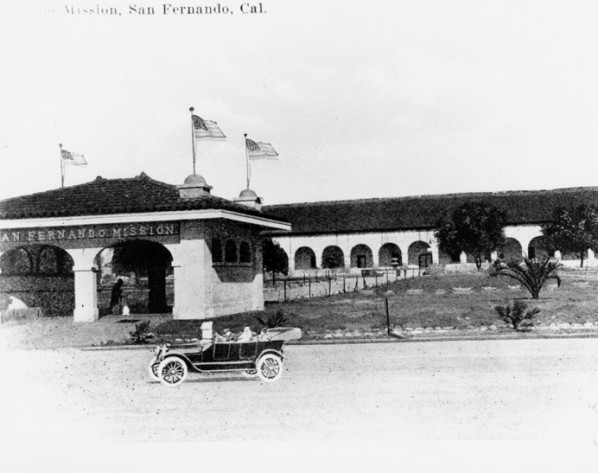 |
|
| (ca. 1920)^* - Exterior view of the entrance of the San Fernando Mission. |
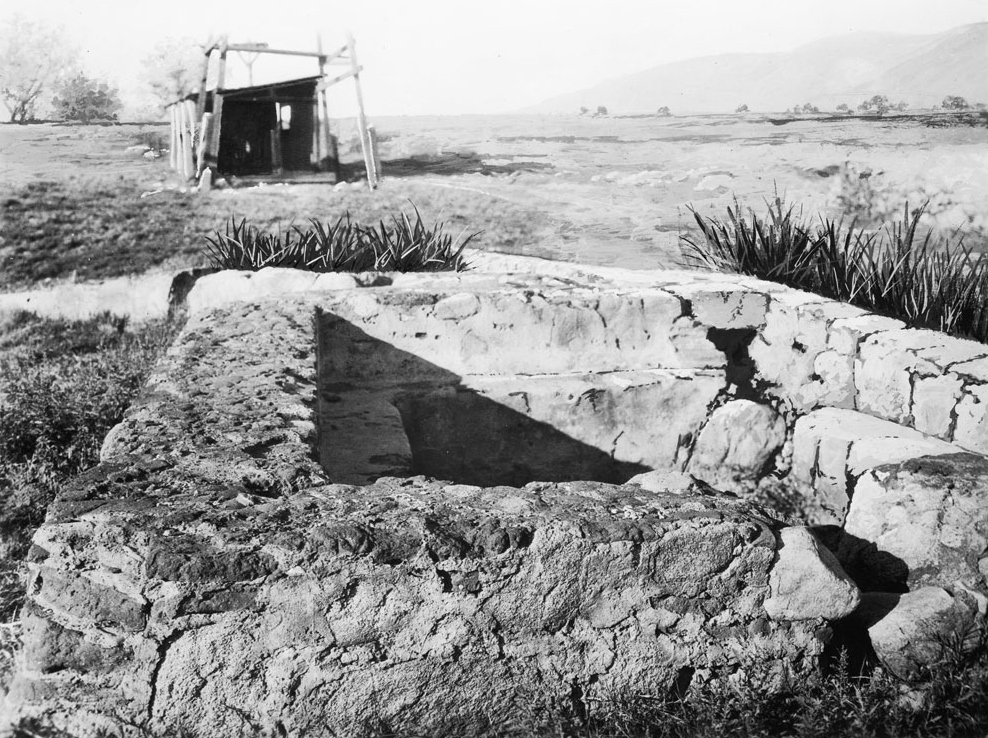 |
|
| (1924)* - Photograph of the water intake irrigation system at Mission San Fernando, December 1924. Picture file card reads: "About 2 miles east of the mission. Right-hand side of wall constructed on picture". The intake is square-shaped and shows signs of deterioration. A dilapidated shack is visible in the background. |
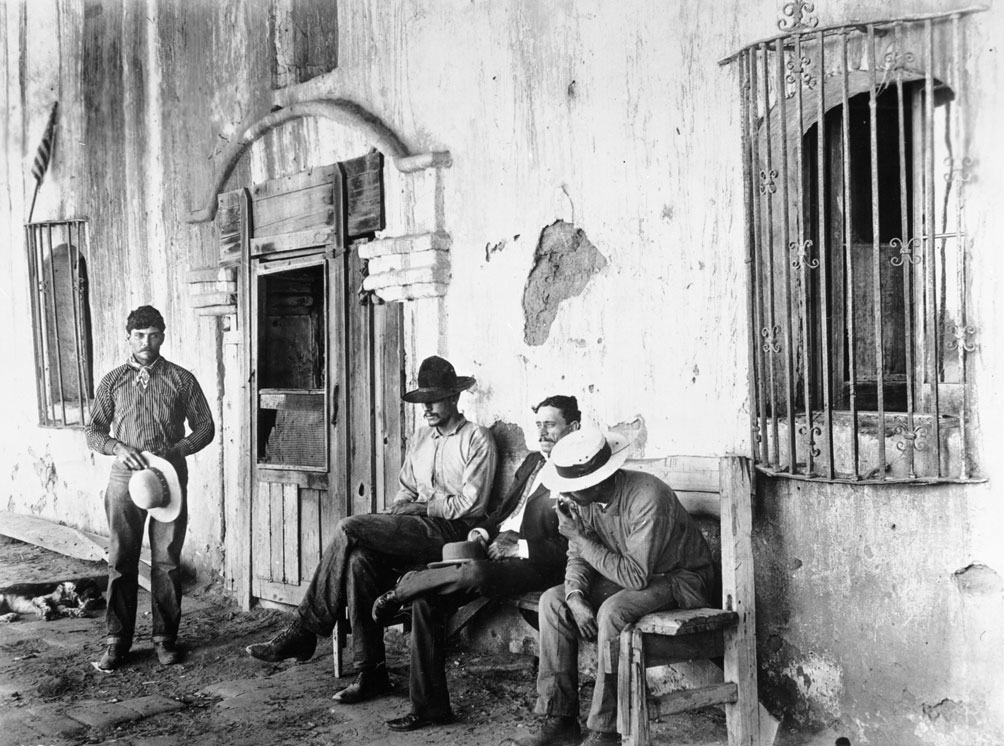 |
|
| (1924)* - Photograph of four Californian men near the entrance of Mission San Fernando, California, Cinco di Mayo, 1924. Three sit on a wooden bench, the fourth stands nearby, his hat in his hands. Stucco has fallen off of parts of the wall of the mission behind them. Decorative bars cover the two visible windows. A dog sleeps on the ground behind the standing man. |
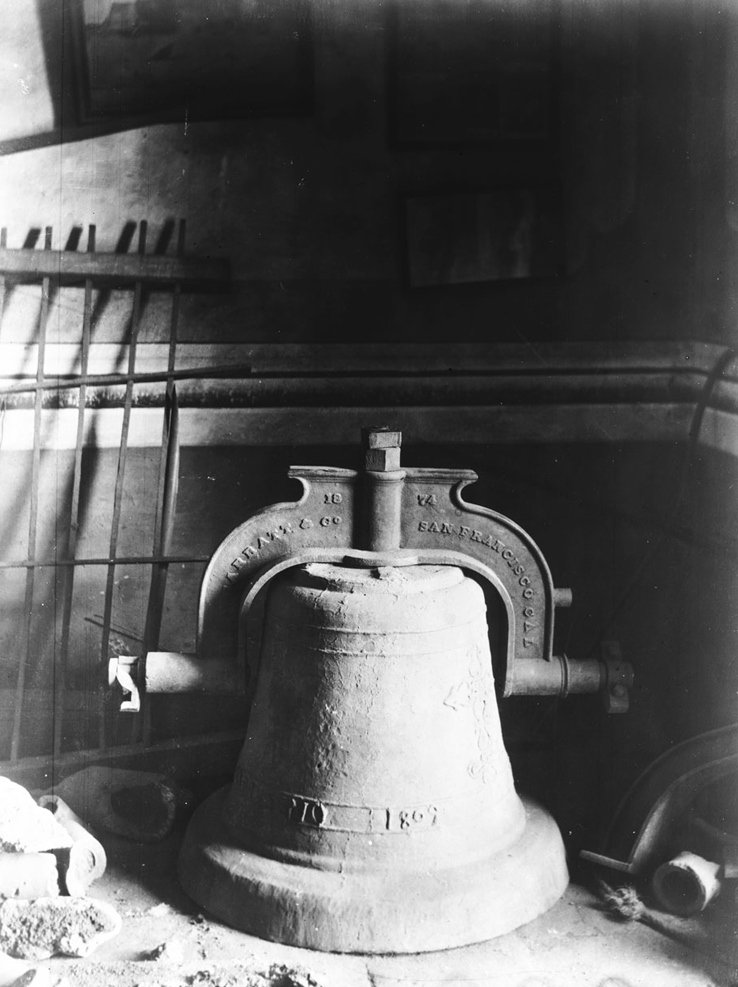 |
|
| (1926)* - Photograph of an old bell from Mission San Fernando. The large metal bell rests on the ground at center. It has a rough surface, and towards the bottom, the words "[¿]mo 1809" are embossed. The arch-shaped bracket that would be used to suspend the bell appears much newer than the bell itself. It is attached to the top of the bell and bears the words "[¿]arratt & Co. 1874 San Francisco Cal". There is a metal grate leaning on the wall behind the bell at left, and there is adobe debris on the ground at left. Several rectangular pictures are hung on the wall at center. |
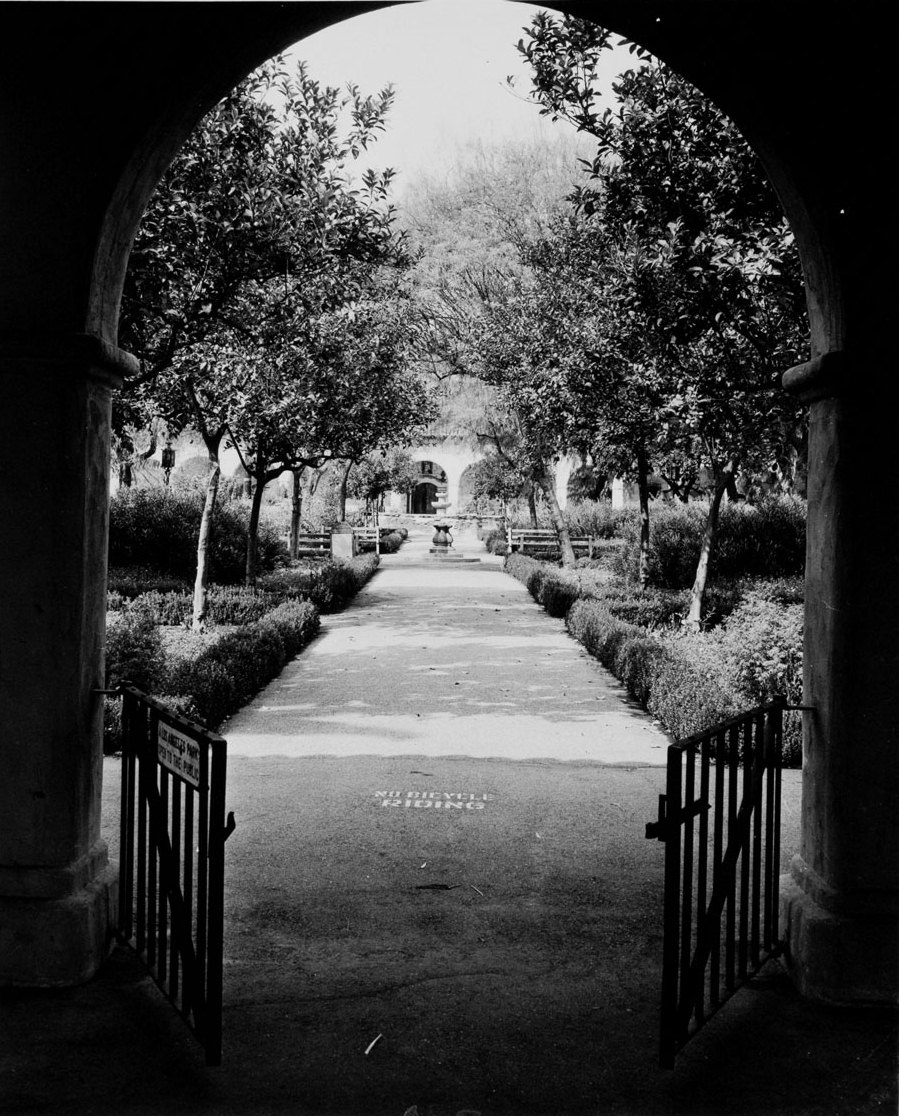 |
|
| (ca. 1926)* - View of Brand Park across the street from the San Fernando Mission, ca.1926. An adobe archway can be seen in the foreground, its opening partially blocked by a low wrought iron gate. Beyond the archway, a neatly landscaped courtyard is visible. Low hedges surround planters where thin trees stand above large bushes. A fountain can be seen in the middle of the courtyard, and a line of light-colored adobe archways is visible in the background at center. In the foreground a sign on the gate reads "A Los Angeles Park open to the public", while writing on the ground reads "No Bicycle Riding". |
Historical Notes Brand Park, also called Memory Garden, was given to the city November 4, 1920. It is a part of the original land grant of Mission San Fernando de Rey de Espana and is located at 15174 San Fernando Mission Boulevard, across the street from the Mission. The entrance gate is located at 15121 South Brand Boulevard. It features a soap works, the original mission fountain, a reservoir and a life-sized statue sculpted by Sally James Farnham of Father Junipero Serra with his arm around an Indian boy. The park was designated California Historic-Cultural Monument No. 150 in 1935. Click HERE to see more in California Historical Landmarks in L.A. |
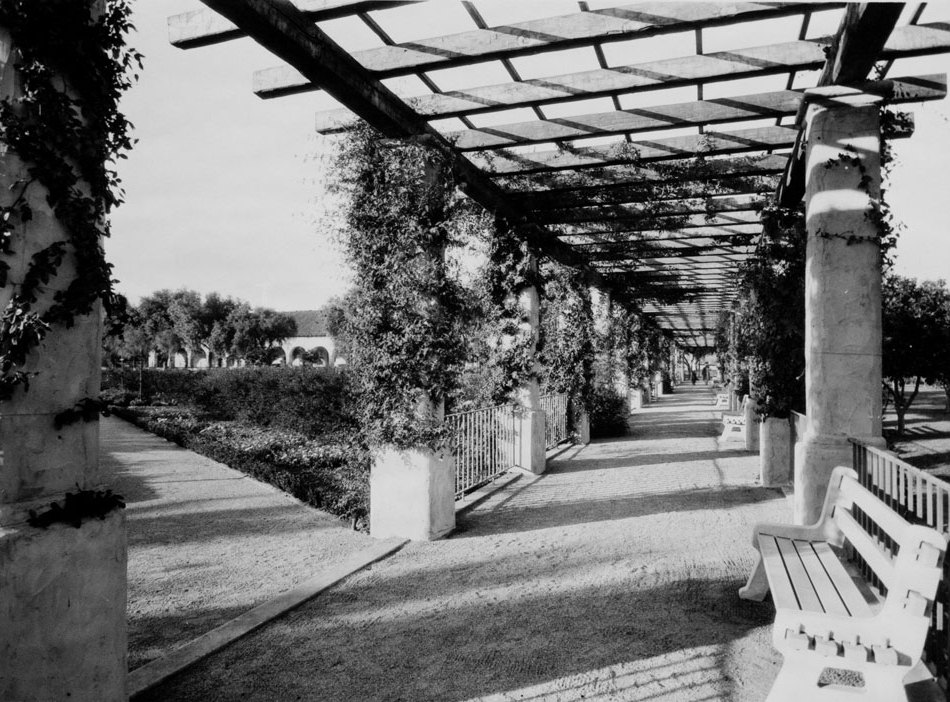 |
|
| (ca. 1926)* - Photograph of Mission San Fernando looking northwest in Pergola of Memory Garden. The pergola runs from the foreground at center to the background at right. Wide adobe posts support an overhead network of wooden beams, and benches are visible along the right side of the covered walkway. Vines climb up the posts and reach across the wooden beams. The edge of the Memory Garden can be seen at left, while the adobe archways of the mission are visible in the background at left. |
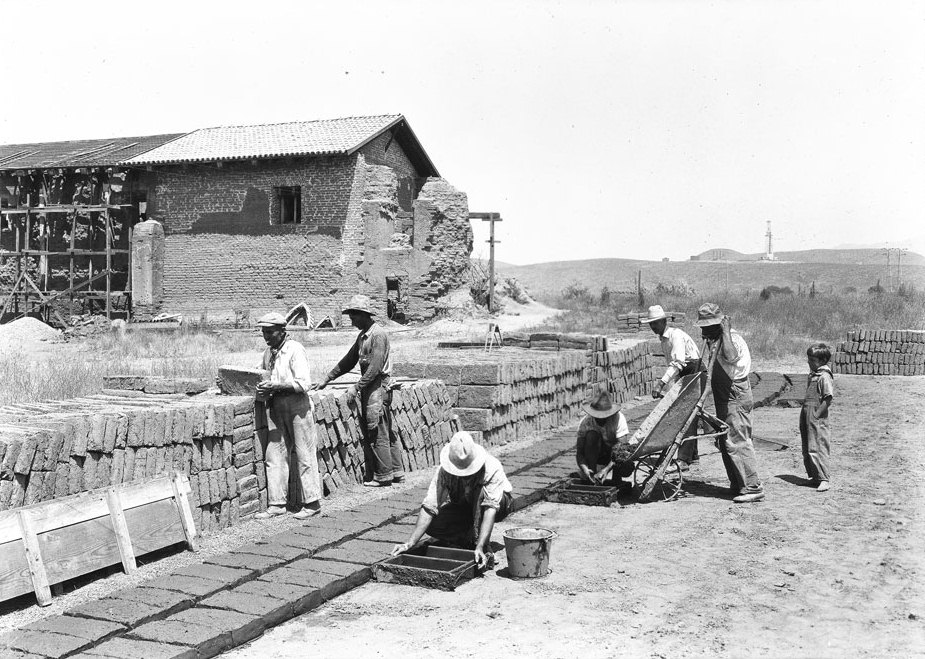 |
|
| (1927)* - Photograph of men renovating the San Fernando Mission, showing adobe brick makers at work in the foreground. A row of fresh adobe bricks can be seen running from the foreground at left toward the background at right. Dry bricks are stacked in a pile that runs parallel to this line. Six men and a boy can be seen moving the bricks, and one of the can be seen using a wheelbarrow at right. The San Fernando Mission building can be seen in the background at left. Its walls are damaged and wooden scaffolding can be seen on the left side of the structure. Hills are visible in the background at right. |
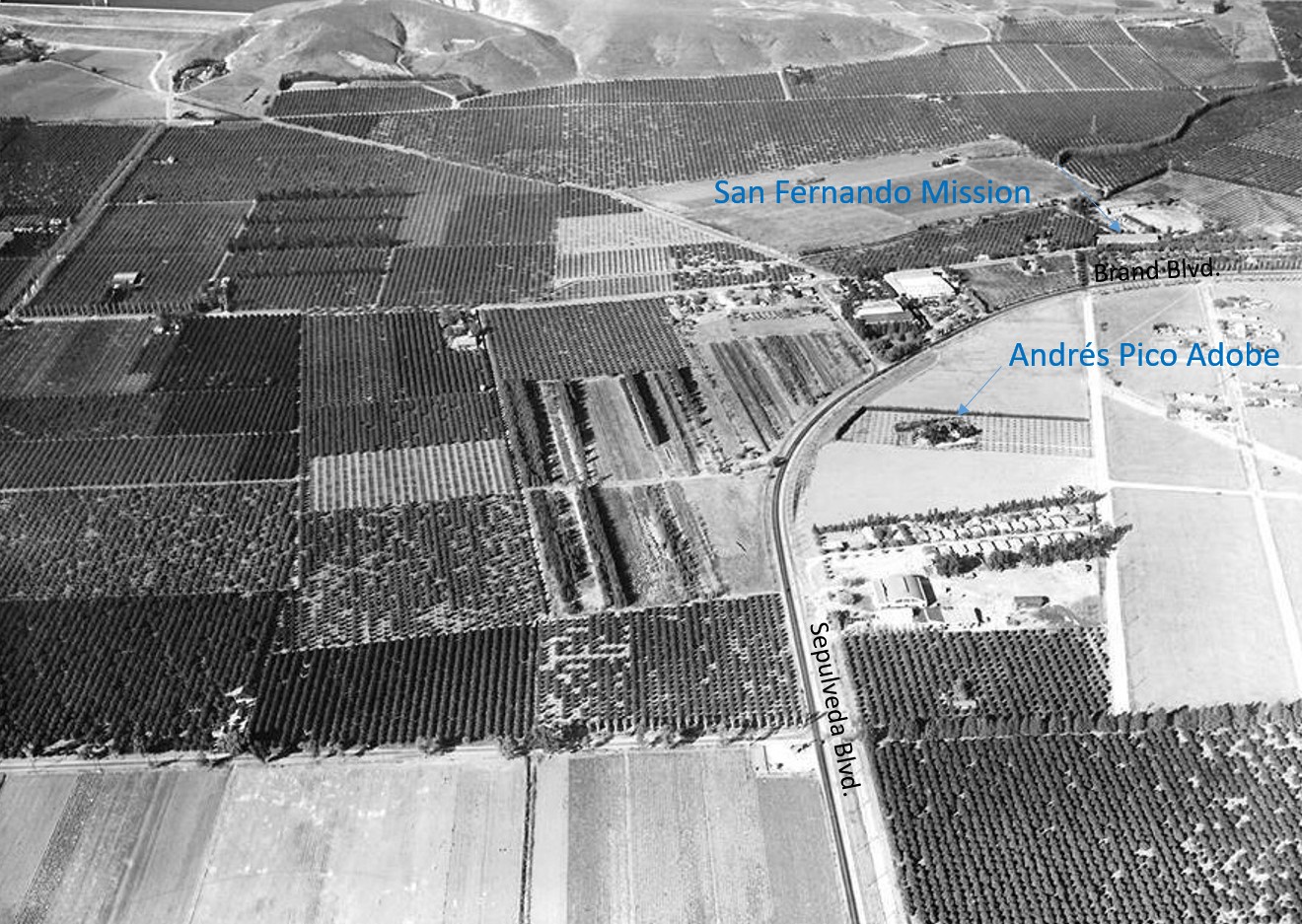 |
|
| (1935)* - Aerial view looking north showing Sepulveda Boulevard running along tracks as it curves into Brand Boulevard. To the right of the curve is the Andrés Pico Adobe. In the upper-right can be seen the San Fernando Mission. Orange and lemon groves can be seen throughout the area. |
Historical Notes Located on Sepulveda Boulevard in Mission Hills, the original part of the Rómulo Pico Adobe was actually built in 1834 by Tongva-Fernandeño, Tataviam-Fernandeño, and Chumash-Ventuaño Native Americans (Indians) from the San Fernando Mission. The original purpose of the structure is unknown, though the adobe was located in the center of the Mission's orchards and surrounding vineyards. Located south of the Rómulo Pico Adobe are a group of buildings belonging to the 'San Fernando Heights Lemon/Orange Association' (Sunkist) buildings. Click HERE to see more. |
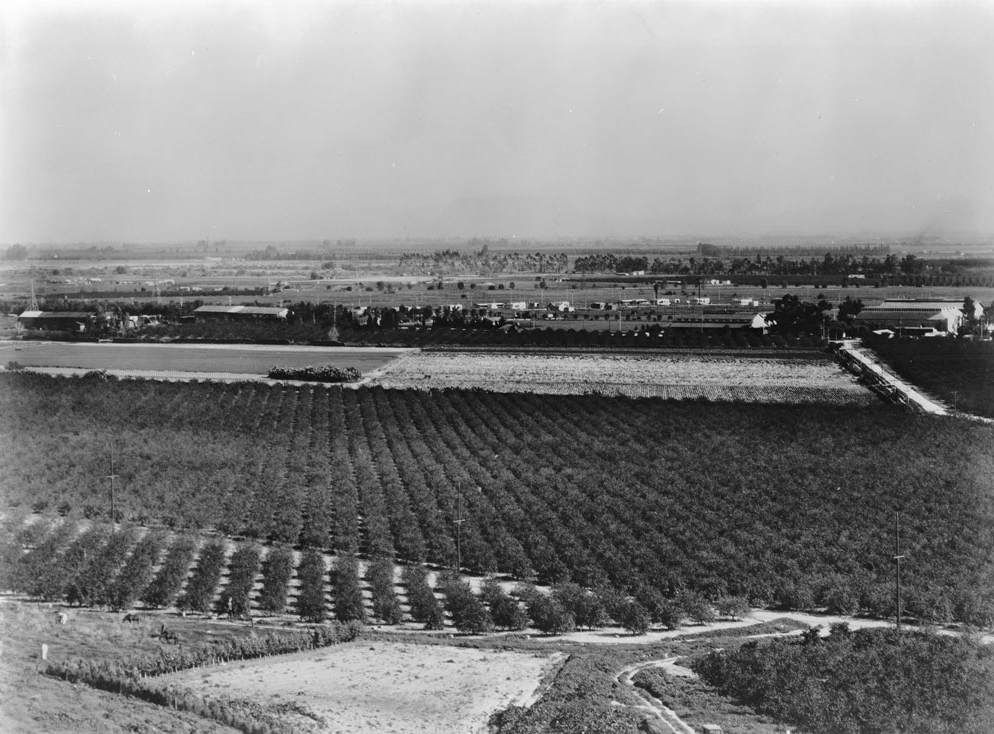 |
|
| (ca. 1930)* - Photograph of a birdseye view over an orchard on the Mission San Fernando, looking southeast from the Santa Susanna Mountains towards the Cahuenga Pass, ca.1930. A wide swath of treetops can be seen spanning the width of the image, while other planted rows stand behind them. Still farther out, residential buildings are spaced out disparately over a large plot of flat ground. In the foreground, a cleared and unplanted patch of soil can be seen. |
Historical Notes The above view is from the top of a hill near where The Odyssey Restaurant is today, in Mission Hills. Center-left is the 'Mission San Fernando Rey de España' (San Fernando Mission). At center is about a dozen houses on Memory Park Ave, built in the mid-1920s. Center-right is the 'San Fernando Heights Lemon Association' (Sunkist) buildings and just below the SFHLA is Stranwood Ave. At bottom, running diagonally, is Rinaldi St. |
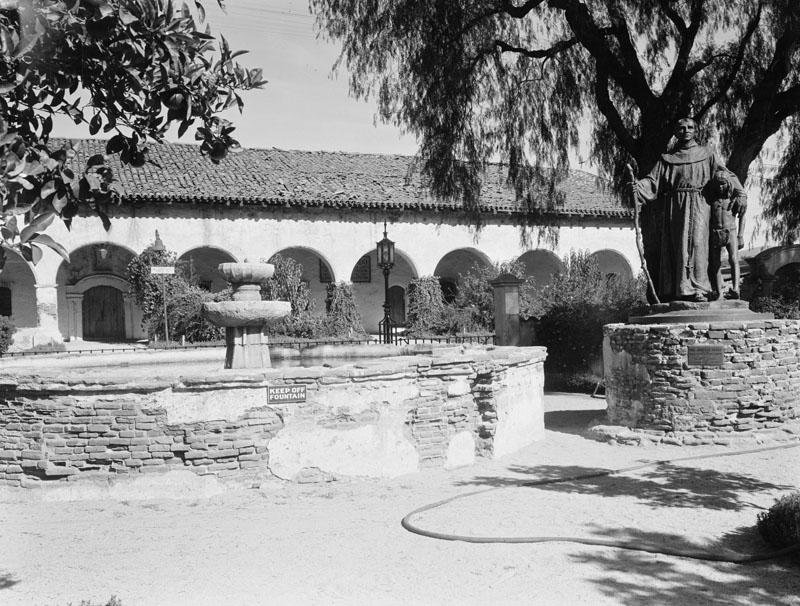 |
|
| (ca. 1936)* - View of the San Fernando Rey de España Mission courtyard, where bull fights were once held. Also visible are a fountain and a statue of Father Junípero Serra. |
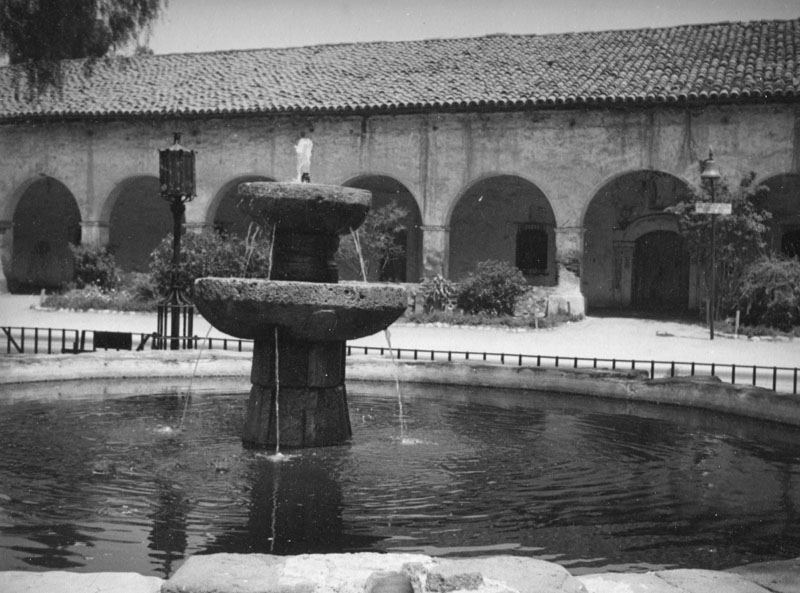 |
|
| (ca. 1937)* - View looking north past the Brand park fountain towards the south facade of the San Fernando Mission arcade and Convento Building. An interesting light fixture stands on the left and an El Camino Real bell can be seen on the right. |
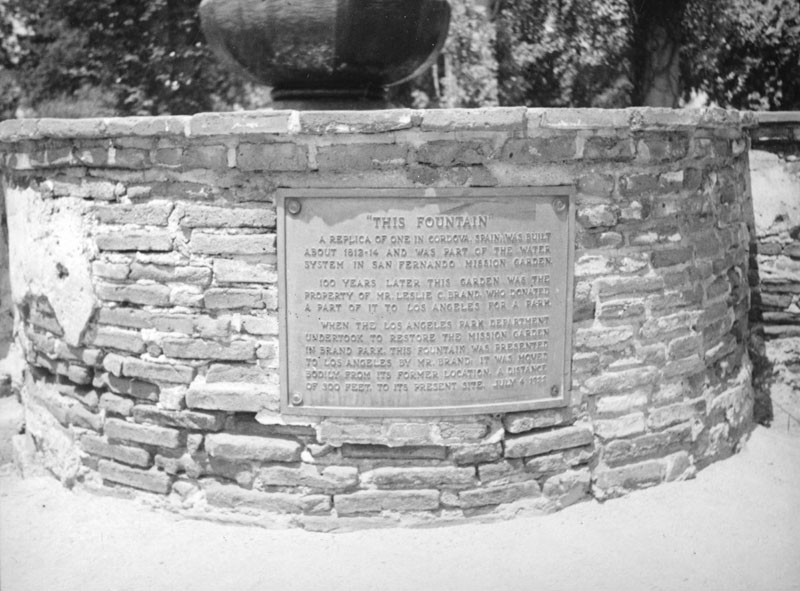 |
|
| (ca. 1937)* - This plaque for the brand park fountain explains that the fountain was replicated from one in Cordoba Spain and was built from 1812-14. Leslie Brand owned the property before donating it to the city, and the fountain was moved 300 feet in 1922. |
 |
|
| (ca. 1936)* - View of the Convento colonnade, or archway, of San Fernando Rey de España Mission. |
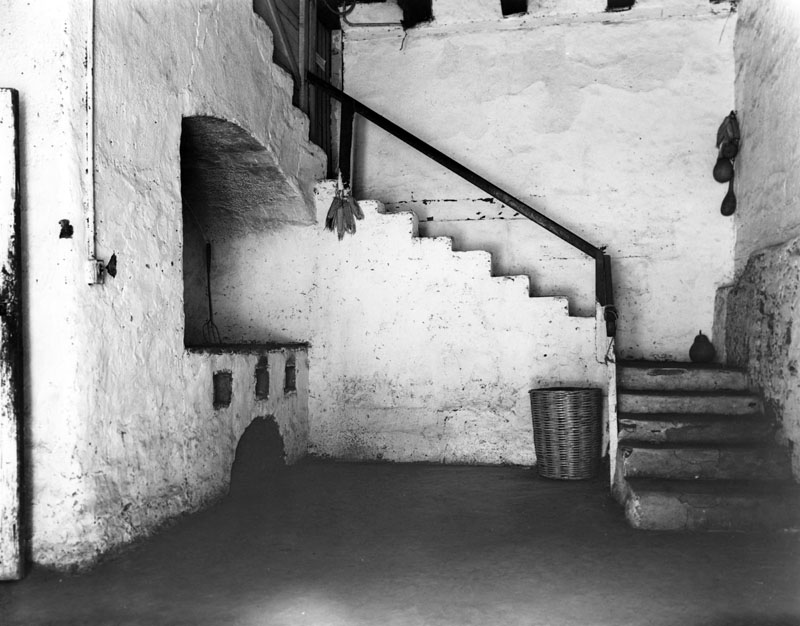 |
|
| (1938)* - Photograph shows the interior of a kitchen, which has an oven and nook nestled in the corner of the room, and a staircase leading up to a wooden door. This kitchen was possibly located inside the Convento Building, also known as the "Long Building". |
 |
|
| (ca. 1938)* - Photograph shows the interior of an attic, or loft, showing rafters, an adobe floor, a couple of pictures hanging on the walls, as well as a few windows and an open door. This attic was possibly located inside the Convento Building, also known as the "Long Building". |
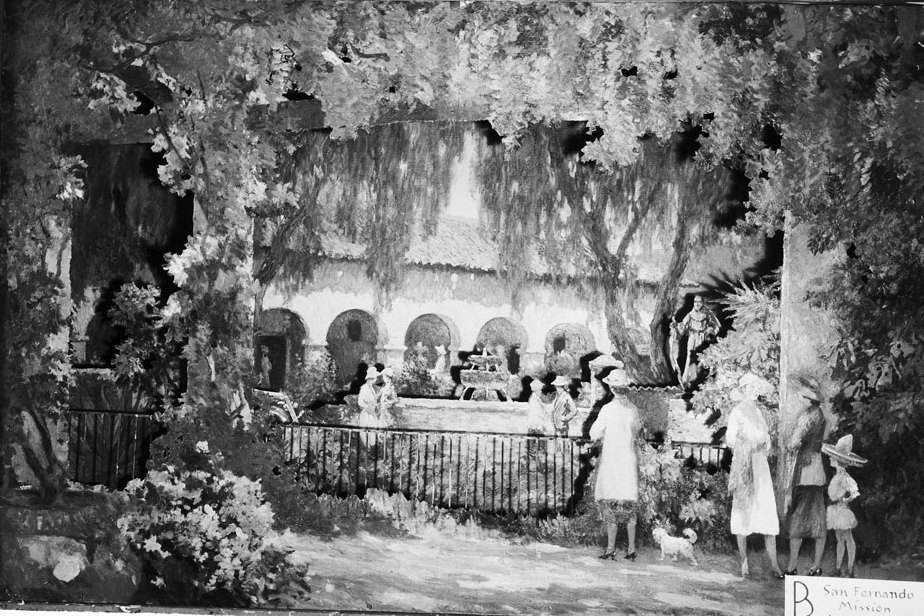 |
|
| (1939)* - Painting of interior plaza of San Fernando Mission, showing fountain at center. |
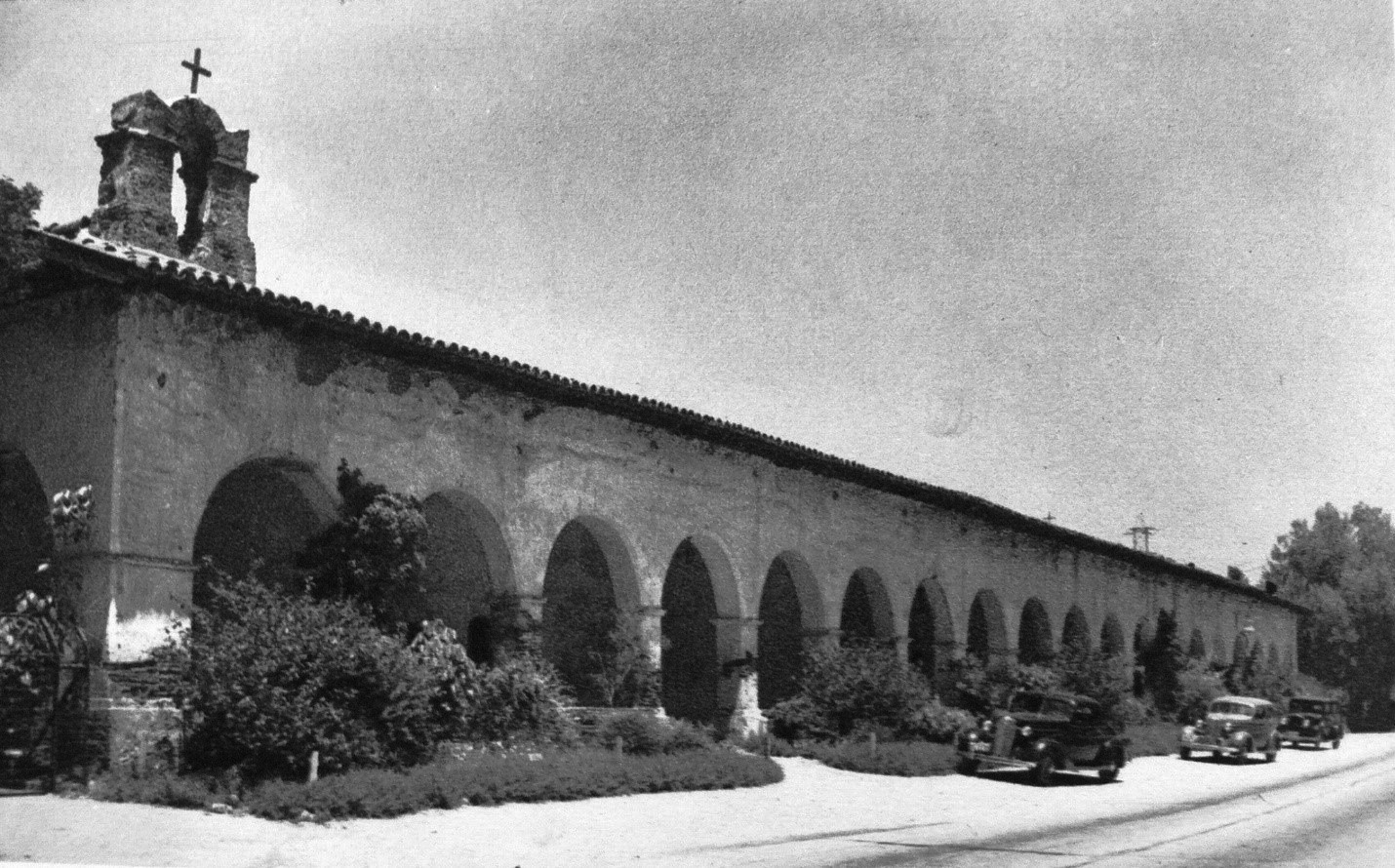 |
|
| (1939)* - View showing the Convento Building with three cars parked in front on the side of San Fernando Mission Blvd. |
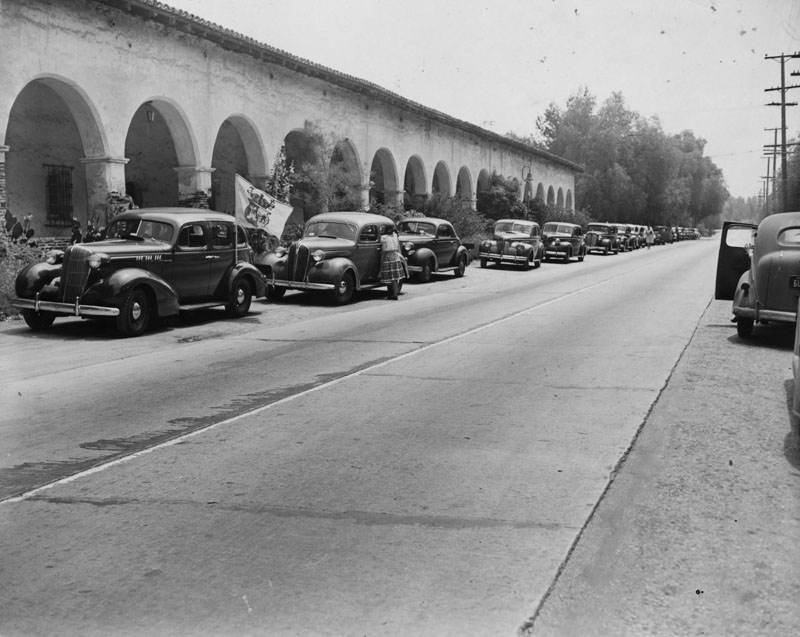 |
|
| (1946)* - Part of the Historical Society's caravan is parked by San Fernando Mission's portico. The Society members are on a tour of the mission. A flag flies from the back fender of the lead car. Photo dated: June 17, 1946. |
 |
|
| (ca. 1950)^* – View of a car stopped in front of the "Long Building", of the San Fernando Mission. |
 |
|
| (1955)* - View of the Convento Building, also known as the "Long Building", as it appeared in the early 1955. |
Historical Notes In 1988, the Convento Building was added to the National Register of Historic Places - Building #88002147. In 1999, the entire Mission San Fernando Rey de España was added to the National Register of Historic Places - Building #71001076. Mission San Fernando Rey de España has also been dedicated as California Historic Landmark No. 157 (Click HERE to see complete listing). |
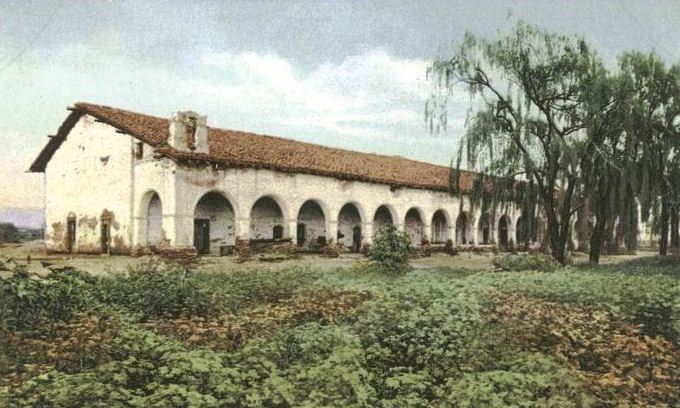 |
|
| (ca. 1900)** - San Fernando Mission postcard. |
Historical Notes Many attempts were made to restore the old Mission from the early 20th century, but it was not until the Hearst Foundation gave a large gift of money in the 1940s, that the Mission was finally restored. In 1971, a large earthquake damaged the church, which had to be completely rebuilt. The repairs were completed in 1974. It continues to be very well cared for and is still used as a chapel-of-ease. In 2003 comedian Bob Hope was interred in the Bob Hope Memorial Gardens.*^ Mission San Fernando Rey de España continues to serve as a parish church.* |
Then and Now
.jpg) |
|
| (1890 vs. 2021)* - San Fernando Mission Then and Now |
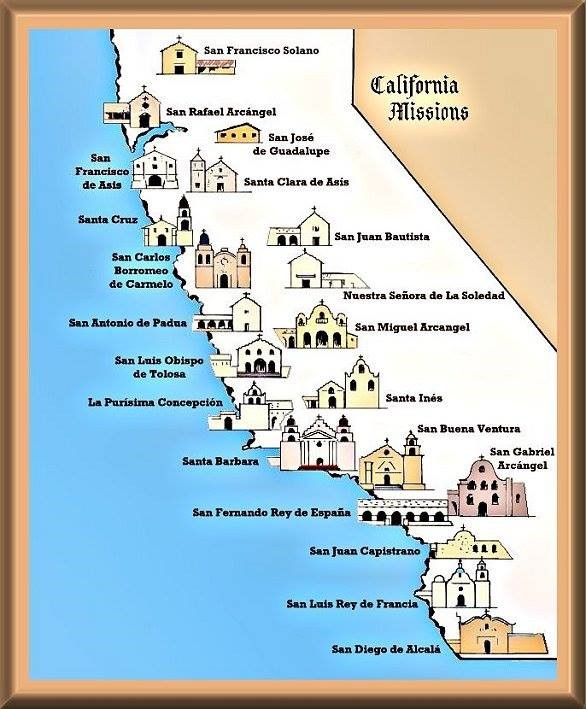 |
|
| (n.d.)* - Map showing the 21 missions in California. Mission San Fernando Rey de España was the 17th mission built in the State. Courtesy of the San Fernando Valley Historical Society & Adobe Museum |
Historical Notes By the time the last mission was built in 1823, the Golden State had grown from an untamed wilderness to a thriving agricultural frontier on the verge of American statehood.The 21 missions that comprise California's Historic Mission Trail are all located on or near Highway 101, which roughly traces El Camino Real (The Royal Road) named in honor of the Spanish monarchy which financed the expeditions into California in the quest for empire. |
* * * * * |
Please Support Our CauseWater and Power Associates, Inc. is a non-profit, public service organization dedicated to preserving historical records and photos. Your generosity allows us to continue to disseminate knowledge of the rich and diverse multicultural history of the greater Los Angeles area; to serve as a resource of historical information; and to assist in the preservation of the city's historic records.
|
More Historical Early Views
Newest Additions
Early LA Buildings and City Views
History of Water and Electricity in Los Angeles
* * * * * |
References and Credits
* LA Public Library Image Archive
^* Oviatt Library Digital Archives
*# California Missions Resource Center
^# San Fernando Valley Relics: The Palms of San Fernando
#^ Facebook: West San Fernando Valley Then and Now
## Library of Congress: Parnoramic View of Convento Building ca. 1907
***Los Angeles Historic - Cultural Monuments Listing
*^*California Historical Landmarks Listing (Los Angeles)
^^^Missions of California: Mission San Fernando, Rey de Espa˜a
*#*KCET - Brief History of Palm Trees
^#^Huntington Digital Library Archive
** Wikipedia: http://en.wikipedia.org/wiki/File:Mission_San_Fernando_Postcard,_circa_1900.jpg
++ The California MIssions Trail
*^ Wikipedia: San Fernando Mission; Charles Fletcher Lummis; Padre Fermín Lasuén
< Back
Menu
- Home
- Mission
- Museum
- Major Efforts
- Recent Newsletters
- Historical Op Ed Pieces
- Board Officers and Directors
- Mulholland/McCarthy Service Awards
- Positions on Owens Valley and the City of Los Angeles Issues
- Legislative Positions on
Water Issues
- Legislative Positions on
Energy Issues
- Membership
- Contact Us
- Search Index